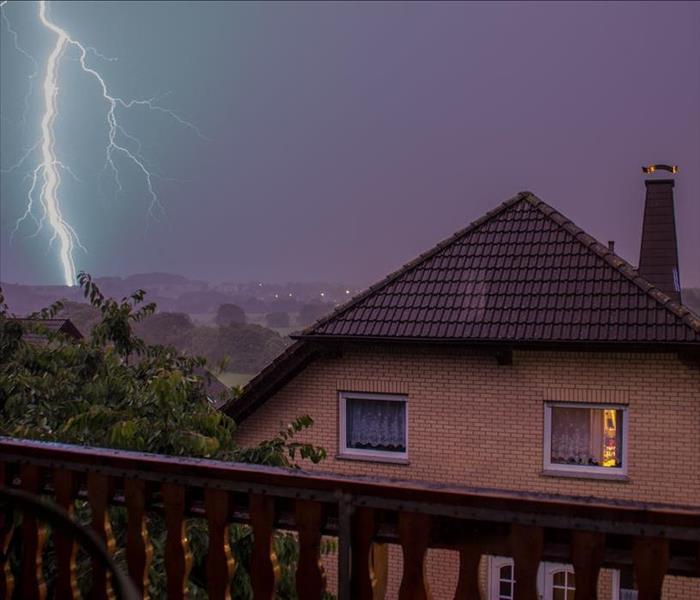Archived Storm Damage Blog Posts
Snowstorm Damage: 5 Critical Steps to Effective Restoration
2/10/2025 (Permalink)
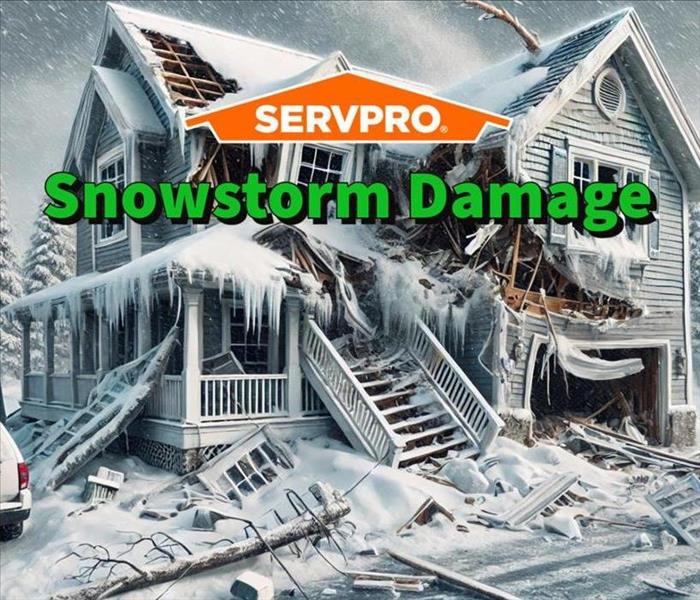 The professionals at SERVPRO are available 24/7 for snowstorm damage restoration!
The professionals at SERVPRO are available 24/7 for snowstorm damage restoration!
This comprehensive snowstorm damage guide provides expert insights and practical steps to protect your property from winter's harshest conditions.
Snowstorms bring freezing temperatures, high winds, and heavy snowfall that can cause severe damage to homes and businesses. Snowstorm damage is a significant concern for property owners, as it can lead to roof collapses, water damage, and structural instability.
This blog post explores the common causes of snowstorm damage, provides essential prevention tips, and highlights how SERVPRO® can restore properties affected by severe winter weather.
What Are the Common Causes of Snowstorm Damage?
Snowstorms can be unpredictable and destructive, leading to costly repairs and disruptions. Some of the most common causes of damage include:
- Heavy Snow Accumulation: Excessive snowfall can add immense weight to a roof, potentially leading to sagging or collapse.
- Ice Dams: When snow melts and refreezes at the roof's edge, it can form ice dams that prevent proper drainage, leading to water infiltration.
- Frozen Pipes: Prolonged exposure to freezing temperatures can cause pipes to freeze and burst, resulting in extensive water damage.
- Strong Winds: High winds during a snowstorm can dislodge shingles, siding, and even entire structures.
- Falling Trees and Debris: Snow-laden trees and branches can break and fall onto buildings, causing severe structural damage.
Understanding these threats is the first step in protecting your property from winter storm damage.
How Can Ice Dams Lead to Property Damage?
Ice dams are a leading cause of snowstorm damage, forming when heat from a building melts the snow on a roof. As the melted snow reaches the colder edges, it refreezes, creating a barrier that prevents proper drainage. This can lead to:
- Water seeping under shingles and into the home
- Structural damage to the roof and ceilings
- Mold growth due to persistent moisture
- Interior water damage, affecting walls, floors, and personal belongings
Preventing ice dams is essential for avoiding costly repairs and maintaining your home's integrity.
Essential Tips to Prevent Snowstorm Damage
Preventing snowstorm damage requires preparation and proactive measures. Here are expert-recommended steps to safeguard your property:
Roof and Gutter Maintenance
- Inspect your roof regularly for weak spots, missing shingles, or sagging areas.
- Clean gutters and downspouts to ensure proper drainage and reduce ice dam formation.
- Consider installing a roof heating system to prevent ice buildup.
Prevent Frozen Pipes
- Insulate exposed pipes, especially in basements, attics, and exterior walls.
- Keep indoor temperatures consistent, even in unoccupied areas.
- Allow faucets to drip slightly during extreme cold to prevent freezing.
Reinforce Your Property's Structure
- Trim tree branches that hang over your home to minimize the risk of falling debris.
- Reinforce roofing and siding to withstand high winds and heavy snowfall.
- Seal gaps and cracks in walls, doors, and windows to prevent cold air infiltration.
Emergency Preparedness
- Know the location of your property's water shutoff valve to prevent flooding in case of a burst pipe.
- For early warning, install smart home devices, such as water leak detectors and programmable thermostats.
- Keep an emergency kit on hand, including flashlights, blankets, and essential supplies in case of a prolonged power outage.
By following these proactive steps, property owners can significantly reduce the risk of snowstorm damage and protect their homes or businesses from winter's harsh conditions.
A Recent Snowstorm Emergency in Dayton, Ohio
Last month, a major snowstorm swept through Dayton, Ohio, causing widespread snowstorm damage to residential and commercial properties. One local business, a family-owned retail store, experienced severe water damage after a massive ice dam formed on its roof. The melting snow had nowhere to drain, leading to leaks that damaged the store's ceiling, walls, and merchandise.
When the business owner noticed water stains forming, they called SERVPRO for emergency restoration. Our team responded promptly, assessing the damage and implementing a targeted action plan:
1. Rapid Water Extraction
Upon arrival, our team used advanced water extraction equipment to remove standing water and excess moisture from the affected areas. This step was crucial in preventing further damage and mold growth.
2. Structural Drying and Dehumidification
After removing the visible water, we deployed industrial-grade air movers and dehumidifiers to ensure complete drying. This process protected the building's structural integrity and prevented secondary damage.
3. Roof and Insulation Inspection
We conducted a thorough roof inspection, identifying the source of the leak and addressing insulation deficiencies that contributed to the ice dam formation.
4. Preventative Measures and Final Restoration
To help prevent future incidents, we recommended improvements such as better attic ventilation and additional insulation. We also restored the store's interior, ensuring a seamless return to business operations.
This successful restoration in Dayton, Ohio, highlights SERVPRO's expertise in handling snowstorm damage and helping property owners recover quickly and efficiently.
What Should You Do When You Experience Snowstorm Damage?
If your property sustains snowstorm damage, taking immediate action is critical. Here's what you should do:
- Assess the Situation: Check for visible damage, such as leaks, roof sagging, or fallen debris.
- Stop Water Intrusion: If a pipe bursts, shut the main water supply off to prevent further damage.
- Document the Damage: Take photos and videos for insurance purposes.
- Contact SERVPRO: Our team is available 24/7 to respond to winter storm emergencies and restore your property efficiently.
- Begin Cleanup: If safe, remove excess water and dry affected areas to minimize secondary damage.
Acting quickly can significantly impact the restoration process and help mitigate long-term damage.
Wrapping Up
SERVPRO specializes in snowstorm damage restoration, providing professional and reliable services when disaster strikes. Our team is equipped with the expertise, technology, and commitment needed to restore homes and businesses efficiently. From immediate water extraction to structural drying and long-term prevention strategies, we ensure your property is safe and secure.
Choosing SERVPRO means more than just repairs—it means partnering with a trusted restoration team dedicated to protecting your investment. Winter storms may be unpredictable, but with the right preparation and SERVPRO's expert restoration services, you can minimize damage and recover quickly.
If you experience snowstorm damage, don't hesitate to contact SERVPRO today for immediate assistance. Let us help you restore your property and peace of mind, no matter how severe the winter weather may be.
Roof Wind Damage: 7 Critical Steps to Restore Your Roof
11/25/2024 (Permalink)
 The professionals at SERVPRO are ready to help you combat storm damage 24/7!
The professionals at SERVPRO are ready to help you combat storm damage 24/7!
Learn How to Address Roof Wind Damage Effectively with SERVPRO®
When powerful winds hit, the integrity of your roof can be at serious risk. Roof wind damage is a frequent concern for property owners, particularly during storm seasons, as it can lead to significant and costly repairs.
Even minor roof damage can result in water intrusion, structural issues, and mold growth without quick action.
This blog post will explore the leading causes of roof wind damage, share practical prevention tips, and showcase how SERVPRO's expertise can be essential in restoring your property after wind-related roofing issues.
What Causes Roof Wind Damage?
Roof wind damage generally occurs when high winds lift, tear, or even break roofing materials, leading to vulnerabilities that worsen over time. Roofs are designed to endure various weather conditions, but when winds exceed 50 mph, the pressure and force can cause significant issues. Common types of roof wind damage include:
- Shingle Damage: High winds can loosen or completely strip roof shingles, exposing parts of your roof to the elements.
- Edge Lifting: Wind can lift the roof's edges, making it easier for water to seep underneath.
- Gutter Damage: Gutters and downspouts are often damaged or dislodged in high winds, affecting drainage.
- Structural Weakness: Winds create a vacuum effect that can loosen structural elements over time, especially if the roof is older or not properly reinforced.
Understanding these causes is crucial to preventing future wind damage and knowing what to look for after a storm.
7 Essential Prevention Tips to Protect Your Roof from Wind Damage
Preventing roof wind damage involves regular inspections, timely maintenance, and reinforcement. Here's how you can protect your property:
- Secure and Inspect Shingles: Loose or damaged shingles are vulnerable to wind. Regularly inspect shingles and have any loose ones secured by a professional.
- Reinforce Roof Edges: Ensuring the edges of your roof are secure can prevent wind uplift. Edge reinforcement can strengthen weak points on the roof, reducing the risk of water intrusion.
- Maintain Your Gutters: Proper drainage is vital to protecting your roof. Clean gutters and check downspouts to ensure water can flow freely and avoid blockages.
- Trim Surrounding Trees: If blown down during strong winds, overhanging branches can cause severe roof damage. Trim trees around your property to avoid fallen branches.
- Check for Loose Flashing: Flashing around vents, chimneys, and skylights should be tightly sealed. Loose flashing is a common vulnerability during wind events.
- Secure Outdoor Items: Patio furniture and equipment can become wind-driven projectiles. Secure or store items before strong winds are forecasted.
- Invest in Professional Roof Inspections: Regular professional inspections can identify and address vulnerabilities early on, helping you avoid major repairs.
Following these steps can make a significant difference in protecting your roof from the effects of wind.
A Real-Life Roof Wind Damage Restoration in Dayton, Ohio
In Dayton, Ohio, SERVPRO was recently called in to address extensive roof damage at a residential property following a particularly intense windstorm. The homeowner noticed missing shingles and water stains on the ceiling, prompting them to contact SERVPRO for emergency restoration.
Upon arrival, our experienced team quickly assessed the damage. It was clear that the high winds had compromised the roof's protective layer, allowing water to infiltrate the attic and insulation. Understanding the urgency, SERVPRO implemented a comprehensive restoration plan, including:
- Immediate Roof Tarping: This initial step prevented further water entry, safeguarding the home's interior until permanent repairs could be made.
- Water Extraction and Drying: After identifying areas where water had seeped in, we deployed advanced extraction equipment and dehumidifiers to remove moisture.
- Roof Repair and Reinforcement: Our team coordinated roof repairs with licensed contractors, ensuring all vulnerable spots were reinforced against future wind events.
- Mold Prevention and Inspection: Although there was no visible mold, we monitored moisture levels to ensure mold prevention in hidden areas.
This Dayton, Ohio scenario illustrates the importance of a swift, expert response to roof wind damage. By contacting SERVPRO immediately, the homeowner mitigated further property damage and received comprehensive restoration services.
SERVPRO's Comprehensive Restoration Approach to Roof Wind Damage
SERVPRO provides a systematic, all-encompassing approach to property restoration after roof wind damage. Our restoration services typically include:
- Initial Damage Assessment: Our SERVPRO team conducts a thorough on-site assessment, documenting the extent of roof damage and identifying immediate needs.
- Temporary Roof Tarping and Board-Up: Our team ensures quick mitigation with tarps or board-ups to prevent additional water or wind damage.
- Water Extraction and Structural Drying: SERVPRO quickly eliminates excess moisture to protect the home's structural integrity by using high-efficiency water extractors and dehumidifiers.
- Mold Prevention: Our advanced drying process helps prevent mold growth, reducing long-term property risks.
- Comprehensive Roof Repair and Reinforcement: We partner with local contractors to provide repairs, ensuring that the roof is restored to withstand future wind events.
- Debris Removal and Cleanup: SERVPRO handles the entire cleanup process, removing all debris and waste materials from the site.
- Post-Restoration Monitoring: We perform follow-up inspections to ensure successful restoration and ongoing protection of your property.
Our expertise and advanced technology ensure that properties affected by roof wind damage receive reliable, effective restoration.
Why Choose SERVPRO for Roof Wind Damage Restoration?
SERVPRO is committed to providing top-tier restoration services built on rapid response, skilled professionals, and cutting-edge technology. Here's why we are the trusted choice for wind damage restoration:
- 24/7 Availability: We understand that emergencies don't wait. SERVPRO is available around the clock and ready to respond at any time.
- Trained and Certified Technicians: Our restoration specialists undergo extensive training in wind and water damage restoration, ensuring they are equipped to handle even the most complex damage scenarios.
- Comprehensive Service: We handle every step, from initial assessment to final repairs, offering a streamlined and hassle-free experience.
- Local Expertise with National Resources: SERVPRO combines local knowledge of weather conditions in Dayton, Ohio, with the resources of a national brand, providing the best of both worlds.
Choosing SERVPRO for your roof wind damage restoration offers more than repair services; it provides peace of mind. We work closely with property owners every step of the way, ensuring transparency and quality throughout the process.
Final Thoughts on Protecting Your Roof from Wind Damage
Roof wind damage can be unpredictable and devastating, but the effects can be minimized with proper preparation and the right restoration partner. By taking proactive measures to reinforce your roof and knowing whom to call in case of an emergency, you can protect your property from significant damage.
Whether you're dealing with the aftermath of a recent windstorm or want a preventative inspection, SERVPRO is ready to help. Our experienced Dayton, Ohio, team is prepared to respond swiftly to any wind-related damage, ensuring your roof and property are restored to optimal condition.
SERVPRO offers the trusted support, expertise, and technology you need to face any storm confidently. With SERVPRO, you're not just getting a restoration service—you're gaining a partner dedicated to safeguarding your property.
Clogged Gutters? 7 Tips To Preventing A Water Damage Crisis
9/9/2024 (Permalink)
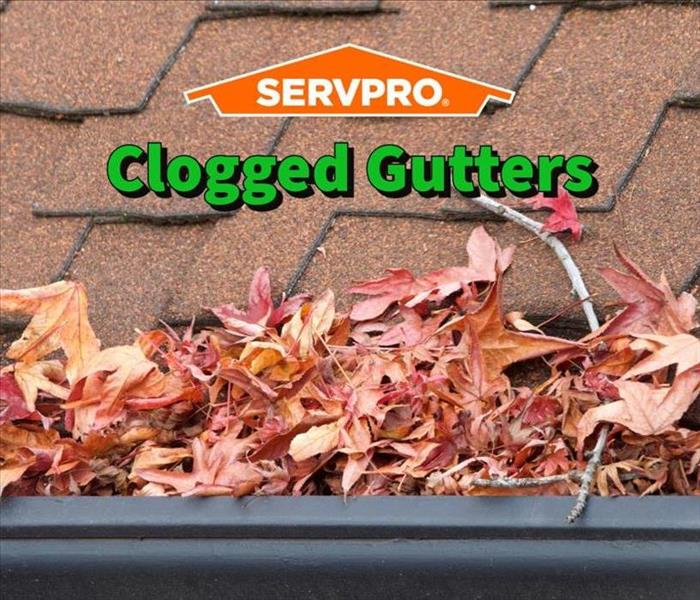 Cleaning your gutters is essential to combat water damage!
Cleaning your gutters is essential to combat water damage!
This resource offers expert advice to safeguard your home from water damage caused by clogged gutters.
Maintaining clean and functional gutters is often overlooked but crucial when protecting your property. Clogged gutters may seem minor, but if left unchecked, they can lead to significant water damage. Understanding how clogged gutters can cause leaks and implementing preventative measures can save your property from costly repairs and extensive damage.
This comprehensive guide will explore how clogged gutters lead to leaks, provide practical prevention tips, and demonstrate how SERVPRO® can help restore your property if a leak occurs.
How Do Clogged Gutters Cause Leaks?
Clogged gutters can become a severe problem when debris like leaves, twigs, and dirt accumulate over time, preventing water from flowing freely through the gutter system. Rainwater has nowhere to go when gutters are blocked, so it overflows. This overflow can lead to water seeping into your home's foundation, walls, and roof, causing leaks and structural damage.
The Dangers of Overflowing Gutters
The impact of clogged gutters can be far-reaching. Here's how overflowing gutters can damage your property:
- Foundation Damage: When water continuously overflows from clogged gutters, it pools around the base of your home. Over time, this can cause cracks in the foundation, leading to structural instability and expensive repairs.
- Roof Leaks: Water that can't flow properly through gutters can back up onto the roof. The excess moisture can weaken shingles and cause leaks, leading to water damage in your attic and upper floors.
- Interior Water Damage: Overflowing water can seep through walls, damaging insulation, drywall, and electrical systems. This water damage often goes unnoticed until it becomes a major problem.
- Basement Flooding: Clogged gutters can contribute to basement flooding, as water seeps through foundation cracks and causes dampness or even standing water in your basement.
Tips to Prevent Gutter Clogs and Leaks
Preventing clogged gutters is critical to avoiding leaks and the subsequent water damage that can follow. Here are some practical steps you can take to keep your gutters clear and your home protected:
- Regular Cleaning: Clean your gutters at least twice a year, ideally in the spring and fall, to remove debris and ensure water flows freely. Consider more frequent cleanings if you live in an area with heavy foliage.
- Install Gutter Guards: Gutter guards can prevent leaves and debris from entering your gutters while allowing water to flow through. These guards reduce the frequency of cleaning and help maintain gutter efficiency.
- Check for Proper Slope: Ensure your gutters are sloped correctly to facilitate water flow toward downspouts. Gutters with an improper slope can cause water to pool and overflow.
- Inspect Downspouts: Regularly inspect downspouts for blockages. Ensure they are clear and direct water away from your home's foundation to prevent pooling and potential damage.
- Trim Overhanging Branches: Trim tree branches that hang over your roof to reduce the amount of debris that falls into your gutters.
- Use a Hose Test: After cleaning your gutters, use a hose to flush water through the system and check for clogs or leaks. This simple test can help you spot potential issues before they become significant problems.
- Professional Inspection: Schedule an annual inspection with a professional to ensure your gutters are in good condition and functioning properly. Professionals can spot issues that may take time to be visible.
A Recent Emergency in Dayton, Ohio
Just last month, in Dayton, Ohio, SERVPRO responded to a call from a homeowner facing severe water damage due to clogged gutters. The homeowner noticed water stains on the interior walls after a heavy rainfall, which we traced back to overflowing gutters. The clogged gutters had caused water to back onto the roof, eventually seeping into the home.
Understanding the urgency, our SERVPRO team quickly mobilized to assess the situation. The inspection revealed extensive water damage to the roof, walls, and even the foundation, where water had pooled after cascading from the clogged gutters. This case underscored the importance of regular gutter maintenance, as the damage could have been prevented with timely cleaning and inspection.
Our response plan included:
- Water Extraction: We immediately began the water extraction, using advanced equipment to remove standing water from the home. Quick action was essential to prevent further damage and mold growth.
- Roof Repair: Our team worked closely with roofing specialists to repair the damage caused by the water backup. This step included replacing damaged shingles and ensuring proper water drainage.
- Structural Drying and Dehumidification: We employed powerful drying and dehumidification equipment to address the moisture that had seeped into the walls and foundation. This process was critical to prevent long-term damage and ensure the home's safety.
- Foundation Inspection and Repair: We thoroughly inspected the foundation to assess any damage caused by the water pooling. Necessary repairs were made to restore the foundation's integrity.
- Gutter Maintenance Recommendations: After restoring the property, we provided the homeowner with a comprehensive guide on gutter maintenance, emphasizing the importance of regular cleaning and inspection to prevent future issues.
What to Do When You Experience Gutter-Related Water Damage
If you suspect clogged gutters have caused water damage to your home, taking immediate action is crucial. Here's what you should do:
- Address the Source: First, clear the gutters of any debris to stop the water overflow. If you cannot do so safely, contact a professional for help.
- Contact SERVPRO: Reach out to SERVPRO for a prompt and professional response. Our team is equipped to handle water damage restoration, ensuring that your home is returned to its pre-damage condition.
- Remove Wet Items: While waiting for professional help, remove any wet items from the affected area and attempt to dry out the space to minimize damage.
- Document the Damage: Take photos and document the damage for insurance purposes. This step can be helpful in expediting the claims process.
Conclusion
Clogged gutters may seem like a minor inconvenience, but if not properly maintained, they can lead to significant property damage. By taking preventive measures and addressing gutter issues promptly, you can protect your home from leaks, water damage, and the costly repairs that often follow.
SERVPRO is your trusted partner in water damage restoration. Our expertise, advanced equipment, and customer satisfaction commitment ensure that your property is fully restored and protected against future water-related challenges. Don't wait until it's too late—regular gutter maintenance and prompt action are crucial to safeguarding your home from the dangers of clogged gutters.
By choosing SERVPRO, you're not just getting a restoration service; you're gaining a partner dedicated to your property's long-term protection and integrity. Let us help you keep your home safe, dry, and free from the hidden dangers of clogged gutters.
Assessing Storm Damage: Your #1 Guide to Efficient Recovery
6/24/2024 (Permalink)
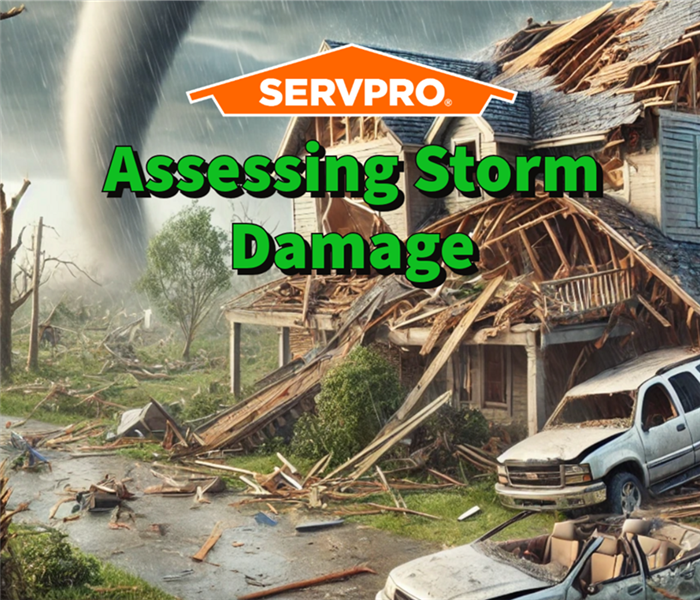 The professionals are ready to help you combat storm damage!
The professionals are ready to help you combat storm damage!
Expert insights and practical steps for safeguarding your property and ensuring swift recovery after a storm.
Storms can unleash a range of damages on both residential and commercial properties, from broken windows and roof damage to flooding and downed trees. Assessing storm damage promptly and accurately is crucial for effective restoration and minimizing further losses. This blog post will explore the importance of storm damage assessment, offer practical tips for conducting thorough evaluations, and highlight how SERVPRO® expertise can be invaluable in restoring properties affected by severe weather.
What is storm damage assessment, and why is it important?
Storm damage assessment involves systematically evaluating a property to identify and document the extent of damage caused by a storm. This process is essential because:
- Facilitates Quick Recovery: Identifying damage promptly allows for faster repair and restoration, minimizing disruption and costs.
- Prevents Further Damage: Early detection of leaks or structural weaknesses can prevent additional damage.
- Ensures Comprehensive Restoration: A thorough assessment ensures all affected areas are addressed, leading to complete and adequate recovery.
- Aids Insurance Claims: Detailed documentation of storm damage is crucial for filing accurate and timely insurance claims.
Common challenges in storm damage assessment
Assessing storm damage can be complex due to various factors:
- Hidden Damage: Some damage, such as hidden leaks or structural issues, may not be immediately visible.
- Complex Property Layouts: Larger or more complicated properties may spread extensive damage over multiple areas.
- Weather Conditions: Ongoing adverse weather can impede assessment and pose additional risks.
Tips for practical storm damage assessment
Conducting a thorough storm damage assessment involves careful planning and execution. Here are some practical steps to guide you through the process:
Prioritize Safety
Before starting the assessment, wear the appropriate safety gear, such as helmets, gloves, and boots. Be cautious of potential hazards like downed power lines and unstable structures.
Conduct an Initial Survey
Perform a preliminary survey of the property to identify significant visible damage. Focus on the roof, windows, doors, and exterior walls. Note any immediate safety concerns that need to be addressed.
Document All Damage
Use a camera or smartphone to take detailed photos and videos of all visible damage. Include close-up shots and wide-angle views to provide a comprehensive visual record. Keep written notes describing the extent and location of each type of damage.
Check for Hidden Damage
Use specialized tools like moisture meters and thermal imaging cameras to detect hidden damage, such as water intrusion and structural weaknesses. Pay close attention to basements, attics, and other less accessible areas.
Assess Structural Integrity
Examine the building's structural integrity, including the foundation, walls, and roof. Look for signs of shifting, cracks, and other structural damage that may compromise the building's stability.
Inspect Electrical Systems
Check the electrical systems for damage, such as exposed wires, damaged outlets, and water intrusion. If there are any safety concerns, turn off the electricity and contact a professional electrician for a thorough inspection.
Evaluate Plumbing Systems
Inspect plumbing systems for leaks, broken pipes, and water damage. Check for signs of water intrusion in walls, ceilings, and floors. Address any visible leaks promptly to prevent further damage.
Communicate with Professionals
Consult with professional restoration experts, like those at SERVPRO, to conduct a comprehensive assessment and develop a detailed restoration plan. Professionals have the expertise and equipment to identify and address all types of storm damage.
A recent storm damage assessment in Dayton, Ohio
Last year, in Dayton, Ohio, SERVPRO was called to assess and restore a storm that severely impacted commercial property had been severely affected by a storm. The storm caused extensive damage, including roof leaks, broken windows, and water intrusion. This situation highlights the importance of a thorough storm damage assessment for effective restoration.
Upon receiving the call, our SERVPRO team quickly mobilized to assess the damage. The action plan included:
- Initial Safety Measures: We ensured the safety of our team and the property occupants by addressing immediate hazards such as broken glass and unstable structures.
- Comprehensive Damage Documentation: Using advanced tools, we documented all visible and hidden damage, including roof leaks, structural issues, and water intrusion in walls and floors.
- Structural and System Inspections: We conducted a detailed inspection of the building's structural integrity and evaluated the electrical and plumbing systems for any damage.
- Restoration Plan Development: Based on our assessment, we developed a comprehensive restoration plan, prioritizing urgent repairs and outlining steps for complete recovery.
- Efficient Restoration Execution: Our team efficiently executed the restoration plan, using advanced equipment and techniques to restore the property to its pre-storm condition.
This incident in Dayton, Ohio, demonstrates the critical role of professional expertise in storm damage assessment and restoration. Our thorough approach ensured that all damage was identified and addressed, allowing the business to resume operations quickly and safely.
Wrapping up
SERVPRO's reputation in storm damage assessment and restoration is built on expertise, advanced technology, and skilled professionals. We understand the complexities of storm damage and the critical role of a thorough evaluation in ensuring effective restoration. Our team is trained to handle all aspects of storm damage, providing efficient and effective solutions.
Choosing SERVPRO for your storm damage assessment and restoration needs offers more than just recovery services; it provides peace of mind and confidence in achieving a successful outcome. Our quick response, cutting-edge techniques, and customer-centric approach make us a trusted partner in navigating the challenges of storm damage. With careful planning and the support of SERVPRO professionals, you can ensure a comprehensive and efficient recovery, protecting your property from further damage and ensuring a swift return to normalcy.
By following these tips and relying on professional expertise, you can effectively assess and restore storm-damaged properties, minimizing damage and ensuring a safe and thorough recovery. Whether dealing with minor storm damage or extensive destruction, SERVPRO is here to help with advanced storm damage assessment and restoration services.
Building Climate Resilience in 2024: A Comprehensive Guide
4/7/2024 (Permalink)
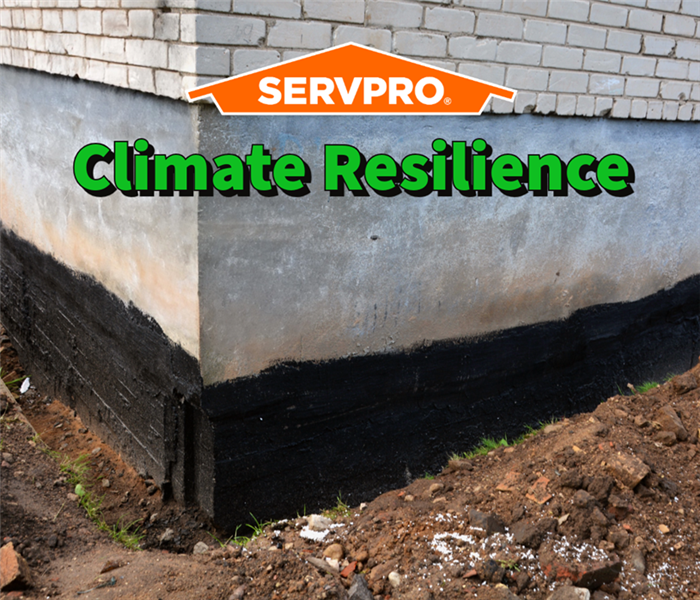 The professionals at SERVPRO are available 24/7 to combat storm damage!
The professionals at SERVPRO are available 24/7 to combat storm damage!
Integrating climate resilience can safeguard your property against extreme weather events.
In the face of growing climate changes, ensuring your property is equipped to handle and recover from extreme weather conditions is not just wise—it's essential. This detailed guide delves into the concept of climate resilience, offering a wealth of strategies for property owners and showcasing the unparalleled expertise SERVPRO® brings to restoration and preparedness. It also highlights a real-world example from Xenia, Ohio.
The essence of climate resilience
Climate resilience is about preparing for, enduring, and bouncing back from climate-related disturbances. For property owners, this entails adopting measures to protect assets against the increasing occurrence of severe weather phenomena such as floods, wildfires, storms, and extreme temperatures.
Strategic steps toward enhanced climate resilience
- Risk identification and management: Begin with a detailed assessment of your property's vulnerabilities. Understanding your property's risks from climate-related events is foundational to crafting an effective resilience strategy.
- Robust structural reinforcements: Upgrading your property to withstand severe weather involves reinforcing structural elements. This could include installing impact-resistant windows and doors, using high-quality roofing materials capable of withstanding high winds, and applying waterproof sealants.
- Adaptive water defense measures: Proactive water defense strategies can significantly benefit properties in flood-prone areas. Elevating critical utilities, installing sump pumps with battery backups, and ensuring proper landscape drainage can mitigate the risks of water intrusion and damage.
- Strategic landscaping: Nature itself offers powerful tools for climate resilience. Through thoughtful landscaping, such as planting native vegetation that can help absorb excess water and using trees as wind barriers, property owners can leverage natural defenses against climate impacts.
- Emergency preparedness: Equipping your property with emergency supplies and a well-considered action plan ensures readiness for any eventuality. Emergency supplies should include water, non-perishable food, batteries, medical supplies, and a clear evacuation strategy.
Illustrating resilience in Xenia, Ohio
Consider a severe storm unexpectedly hitting Xenia, Ohio. This storm, characterized by high winds and torrential rains, illustrated the unpredictability and destructive potential of climate change-induced weather events. It caused widespread damage to homes and businesses, testing the community's climate resilience.
SERVPRO's rapid deployment to the area underscored the critical importance of swift, professional action in the aftermath of climate events. Our IICRC-certified restoration team, equipped with advanced restoration technology and extensive experience, immediately assessed the damage, extracted water, and began the restoration process. Our efforts facilitated the recovery of affected properties and emphasized the need for ongoing preparedness and resilience initiatives.
Proactive measures following extreme weather damage
After ensuring the safety of all individuals:
- Secure the property: Take initial steps to prevent further damage, such as covering broken windows or turning off the main water supply to avoid flooding.
- Professional consultation: It is crucial to contact a professional restoration service like SERVPRO. Our expertise and equipment are vital for effective damage assessment, mitigation, and repair.
Why SERVPRO stands out
Opting for SERVPRO for your restoration and resilience-building needs means entrusting your property to experts adept at addressing the immediate aftermath of climate events and committed to enhancing your property's long-term resilience. With a focus on innovative solutions and customer service, SERVPRO ensures that your property is prepared to face future climate challenges head-on.
In summary
Building climate resilience is imperative for property owners in today's volatile environment. By implementing strategic measures, engaging with professionals, and fostering a culture of preparedness, it is possible to reduce the risks associated with extreme weather events significantly. SERVPRO remains a dedicated partner in this endeavor, offering the expertise and resources needed to protect and preserve your property amidst the challenges posed by climate change.
With comprehensive planning, strategic investment in property improvements, and the support of SERVPRO's restoration services, you can navigate the complexities of climate resilience, ensuring that your property stands secure and is ready to face whatever the future may hold.
Expert Ice Dam Removal: 5 Excellent Questions to Ask
1/29/2024 (Permalink)
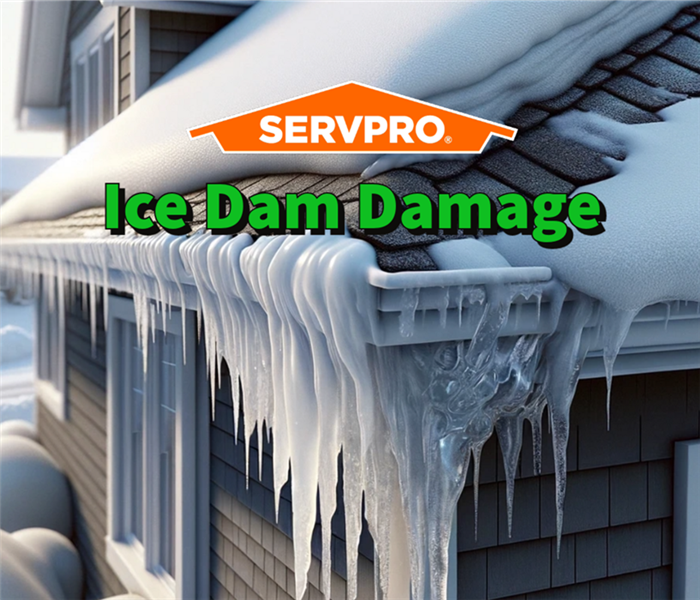 The professionals at SERVPRO are a call away from helping you combat damages caused by ice dams.
The professionals at SERVPRO are a call away from helping you combat damages caused by ice dams.
Navigating the complexities of ice dam issues doesn’t have to be daunting for property owners.
Welcome to the SERVPRO® realm of property mastery, where we navigate the intricacies of seasonal challenges. In this in-depth guide, we confront the winter menace of ice dams. Join us as we explore the five pivotal questions to ask ice dam removal experts, delving into the complexities of this frosty adversary. Realize the importance of informed decision-making through a compelling scenario in Beavercreek, Ohio, where a commercial property sought the expertise of our SERVPRO team to combat ice dam damage and witness the meticulous restoration that followed.
Why are ice dams a problem?
Ice dams materialize when melted snow refreezes at a roof's edge, creating a barrier that obstructs proper drainage. The resulting water intrusion poses a threat to a property's structural integrity and insulation and opens the door to potential mold issues. At SERVPRO, our approach to ice dam challenges is grounded in a comprehensive understanding of the multifaceted problems they can pose.
Does an ice dam mean I need a new roof?
Contrary to a common misconception, ice dams don't automatically mandate a total roof replacement. In a recent Beavercreek scenario, a commercial property faced severe ice dam issues leading to leaks and compromised insulation. Our SERVPRO experts conducted a meticulous assessment, revealing that targeted repairs and expert ice dam removal techniques could salvage the existing roof, offering significant cost savings to the property owner.
How can professionals help with ice dam removal?
Ice dam removal demands precision and expertise, qualities intrinsic to SERVPRO's approach. Our professionals excel in utilizing cutting-edge techniques, such as steam-based methods, to safely and efficiently eliminate ice dams. In Beavercreek, our team removed the existing ice dams and conducted repairs to address structural issues caused by water intrusion, ensuring a fully restored commercial property.
Can ice dam damage lead to mold issues?
Indeed, water intrusion resulting from ice dams creates an environment conducive to mold growth. SERVPRO's comprehensive approach ensures not only the removal of ice dams but also the prompt addressing of potential mold issues. Thorough inspections and targeted remediation strategies guarantee your property is safeguarded against secondary problems like mold growth.
What sets SERVPRO apart in ice dam removal?
SERVPRO's commitment to excellence shines in every facet of ice dam removal. Our rapid response, advanced techniques, and comprehensive restoration approach were exemplified in Beavercreek. Beyond addressing visible issues, we ensure a holistic restoration that exceeds expectations, setting us apart as the pinnacle of efficiency and expertise in ice dam removal.
Scenario in Beavercreek, Ohio:
In the heart of winter, a commercial property in Beavercreek found itself dealing with severe ice dam damages. Leaks and compromised insulation painted a grim picture, prompting an urgent call to SERVPRO. Responding promptly, our team conducted a meticulous assessment, identifying the extent of the ice dam issues. We efficiently removed the ice dams that plagued the property by leveraging state-of-the-art steam-based methods. Subsequent repairs addressed structural concerns caused by water intrusion, leaving the commercial property not just ice dam-free but fully restored to its pre-damage condition.
Call SERVPRO for help!
Choosing the right restoration experts is pivotal in the face of ice dam challenges. SERVPRO's proven success, showcased by our recent Beavercreek intervention, underscores our commitment to excellence. Opting for SERVPRO means selecting a team that goes beyond basics, provides tailored solutions, and prioritizes the longevity and integrity of your property. Don't let ice dams dictate your property's fate – trust SERVPRO for expert ice dam removal and restoration services, ensuring your peace of mind during winter's challenges. Our track record speaks for itself – when it comes to ice dam removal, SERVPRO stands as the epitome of efficiency and expertise, ready to master the chill and restore your property to its full glory.
Roof Hail Damage: Take These 5 Simple Steps After It Happens
11/13/2023 (Permalink)
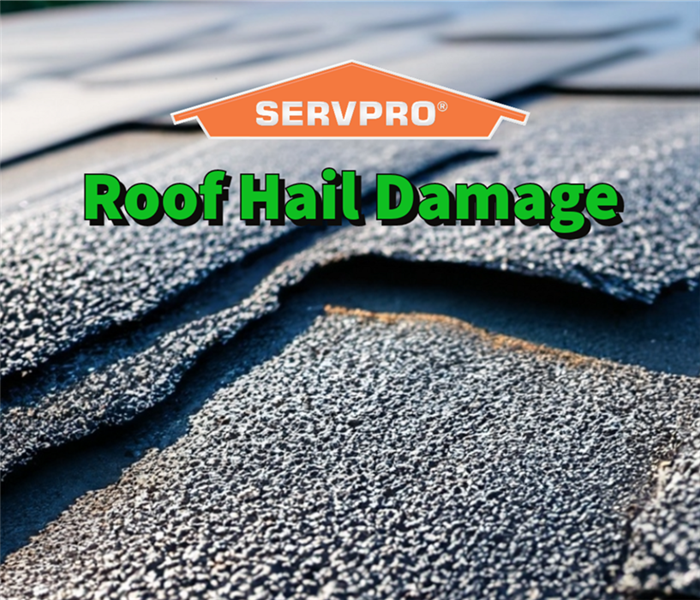 The professionals at SERVPRO understand the importance of quickly addressing roof hail damage.
The professionals at SERVPRO understand the importance of quickly addressing roof hail damage.
Roof hail damage can cause severe structural issues when left unaddressed.
Hailstorms are among nature’s most potent forces, transforming ice into projectiles that can wreak havoc on the integrity of a home, particularly the roof. When a violent hailstorm struck Beavercreek, Ohio, residents were left grappling with the aftermath of weather-inflicted property damage.
The following blog post will cover everything you need about roof hail damage and how our SERVPRO® team in Dayton responds to homes battered by nature’s fury.
How can you tell if a roof is hail-damaged?
After any hailstorm, the most pressing concern for homeowners is determining the extent of the damage inflicted on their roofs. Roof hail damage often manifests in several forms—from noticeable indentations and cracks to less visible granule loss on asphalt shingles.
Following the mentioned storm in Beavercreek, homeowners quickly noticed the dents on their siding and gutters, a primary indication of the potential damage to their rooftops. Our SERVPRO team conducted a thorough assessment upon their arrival, revealing visible dents and depressions on the shingles and soft spots—much like a bruise on an apple—signaling severe damage underneath.
Should a roof be replaced after hail damage?
Deciding whether to replace a roof after hail damage depends on the severity of the damage. For some, a total replacement is necessary to maintain the roof’s structural integrity, while others may only require repairs to specific sections.
After the recent Beavercreek hail storm, the SERVPRO professionals evaluated the extent of the hail damage using industry-leading techniques and tools. The damage was significant, with a compromised waterproof barrier, which necessitated repairs and a complete roof overhaul. A timely intervention prevented potential long-term issues, such as water leaks or insulation problems, which could have led to more extensive damage inside the home.
Will insurance pay for hail damage?
Insurance coverage is a common and critical question for homeowners. Typically, home insurance policies cover the damage caused by hail. However, the insurance claims process can be intricate and demands precise documentation.
The homeowners in Beavercreek faced the daunting task of insurance paperwork following the hail damage. SERVPRO professionals provided comprehensive damage documentation, a critical service that streamlined the insurance claim process. The detailed records and photographic evidence supplied by the SERVPRO team ensured that the homeowners could present a solid case for their insurance providers, leading to justified coverage for their loss.
What are the immediate steps to take following roof hail damage?
Immediate action is vital to prevent further damage after a hailstorm. Here’s what SERVPRO did in Beavercreek:
- Assessment: Our team arrived promptly to conduct an exhaustive evaluation, identifying all areas of damage.
- Protection: We secured the compromised roof areas with tarps to shield the interior from water damage.
- Water Removal: Using powerful pumps and vacuums, we extracted water that had started to leak into the property.
- Drying: Industrial-grade dehumidifiers and air movers were employed to ensure the property was thoroughly dried.
- Restoration: Damaged materials were removed and replaced, and the entire roof was restored to a condition that met or exceeded its original integrity.
Why is it crucial to have professionals address hail damage immediately?
Hail damage is insidious and can escalate if not promptly and adequately addressed. Quick, professional intervention is necessary to mitigate immediate water damage and to prevent long-term structural issues. SERVPRO’s team of experts specializes in direct response and takes proactive steps to avoid the aggravation of hail damage. In Beavercreek, our intervention saved the roof and interior from potential mold growth and structural weakness.
Why choose SERVPRO for roof hail damage cleanup?
When confronting the chaos of roof hail damage, choosing the right storm damage professionals can mean the difference between a quick return to normalcy and prolonged, expensive restoration. Here’s why SERVPRO stands out:
- Expertise and experience: With in-depth knowledge of the construction and restoration processes, SERVPRO experts bring a wealth of experience to every project.
- Swift response: SERVPRO understands the urgency of hail damage, ensuring a prompt and efficient response to prevent further damage.
- Insurance liaison: We simplify the complexities of the claims process, working directly with insurance companies to ease homeowners’ burdens.
- Comprehensive solutions: From initial damage assessment to final touches in restoration, SERVPRO provides a full spectrum of services to bring your property back to pre-storm conditions.
What recently happened in Beavercreek is a testament to SERVPRO’s commitment to restoring each property with precision and care, turning overcast post-storm worries into a silver lining. Choosing SERVPRO for roof hail damage cleanup ensures a robust, reliable, and resilient return to safety and comfort.
Garage Door Damage: 6 Effective Strategies For Your Property
8/28/2023 (Permalink)
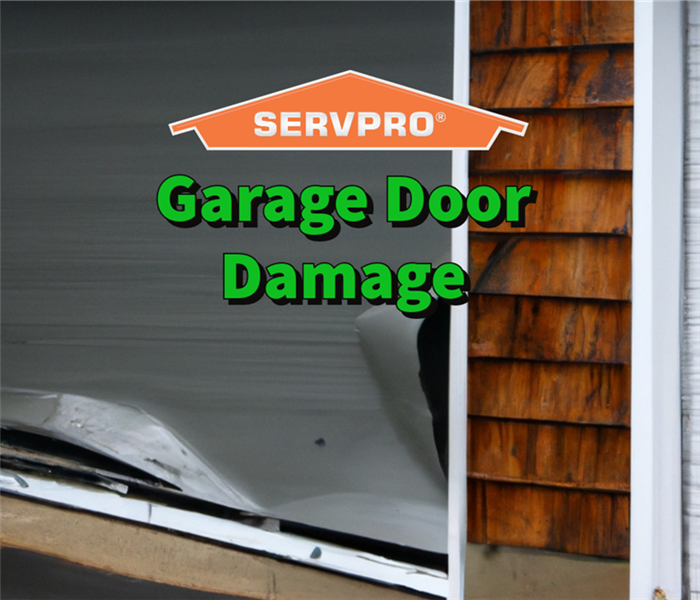 Your garage door will be repaired quickly with the help of SERVPRO!
Your garage door will be repaired quickly with the help of SERVPRO!
Don’t let the destructive forces of nature affect your home—safeguard yourself from garage door damage!
When turbulent winds of a storm gather momentum and threaten to unleash their fury, the garage door is one of the most vulnerable points of any home. Though the garage door might seem sturdy, it can be susceptible to the relentless onslaught of storms alongside siding and windows.
This blog post will delve into safeguarding your garage door against storm damage. We will explore common signs of garage door damage, offer tips on how to protect your garage door from the wrath of nature and shed light on why SERVPRO® should be your go-to choice for restoring your property to its former glory in the wake of a storm. Let’s fortify your garage against any storm’s rage!
What are the common signs of garage door damage?
Garage doors might appear robust, but even a minor breach in their integrity can have a cascading effect. Signs of garage door damage are often more subtle than one might imagine. Look out for misaligned tracks, unusual noises during operation, sagging sections, and frayed cables. An impaired garage door isn’t just a cosmetic issue—it’s an open invitation to storm damage. Promptly addressing these signs can save you from major headaches down the road.
6 tips to protect your garage door from storm damage
In the face of an impending storm, proactivity is vital to fortifying your garage door against potential destruction. Here are some tried-and-true strategies to shield your garage door from the wrath of Mother Nature:
- Reinforce door materials: Consider upgrading to reinforced steel or aluminum doors. These materials offer enhanced durability, making them more resistant to storm impact.
- Install bracing systems: Invest in a high-quality bracing system that can help distribute the force of wind and debris impact, thereby reducing the chances of structural damage.
- Regular maintenance: Your garage door requires regular maintenance, like any high-volume part of your home. Lubricate moving parts, inspect cables and ensure the door’s alignment is spot-on.
- Secure windows: If your garage door has windows, reinforce them with shatter-resistant film to prevent the glass from shattering during a storm, thereby reducing the risk of further damage.
- Trim nearby trees: Overhanging branches can turn into projectiles during a storm, causing significant damage. Keep them trimmed and well-maintained to minimize this risk.
- Storm-ready garage door: Consider investing in a garage door designed to withstand storms. These doors are engineered with robust materials and reinforced designs that can significantly reduce the impact of extreme weather.
SERVPRO’s rapid response to a storm-damaged garage door
Earlier this year, a sudden and violent storm tore through the area, leaving behind a wake of destruction. One of the properties affected was that of the Johnson family. Battered by the relentless wind, their garage door was torn from its hinges, exposing their belongings to the elements. Distraught and unsure where to turn, they contacted SERVPRO for help. Our team arrived promptly, assessing the damage and developing a comprehensive restoration plan.
Utilizing our state-of-the-art equipment and industry expertise, we began the restoration process. Our technicians secured the property, preventing further damage, and worked tirelessly to repair and restore the garage door to its pre-storm condition. The Johnson family expressed their gratitude for our swift response, professional approach, and meticulous attention to detail that our team displayed throughout the restoration journey.
Why choose SERVPRO for storm restoration services?
Choosing the right partner for storm restoration services can make all the difference in restoring your property efficiently and effectively. Here’s why SERVPRO stands out in the realm of storm damage restoration:
- Rapid response: Storm damage requires immediate attention. SERVPRO’s 24/7 availability ensures that our expert teams are always ready to respond to your distress call, minimizing the extent of damage.
- Comprehensive expertise: Our technicians undergo rigorous training, equipping them with the knowledge and skills to handle various storm-related restoration challenges.
- Cutting-edge equipment: We invest in advanced technology and equipment to address storm damage with precision and efficiency.
- Personalized approach: We understand that every restoration project is unique. Our tailored solutions ensure your property receives the specific care it needs to recover fully.
- Insurance liaison: Dealing with insurance companies can be overwhelming. SERVPRO’s experience working with insurance providers ensures a seamless claims process, alleviating unnecessary stress.
Conclusion
When storm clouds gather and threaten your home, fortifying your garage door becomes crucial for protecting your property. By recognizing the signs of garage door damage, implementing preventive measures, and knowing that SERVPRO is your steadfast ally with our industry-leading storm restoration services, you can ensure that your home weathers the storm and emerges more robust than before. The Johnson family’s experience is a testament to the unmatched expertise and dedication SERVPRO brings. Trust SERVPRO for storm restoration services, and let us be the guiding light in the aftermath of nature’s fury.
Thunderstorm Damage: 4 Effective Ways SERVPRO Can Help!
6/12/2023 (Permalink)
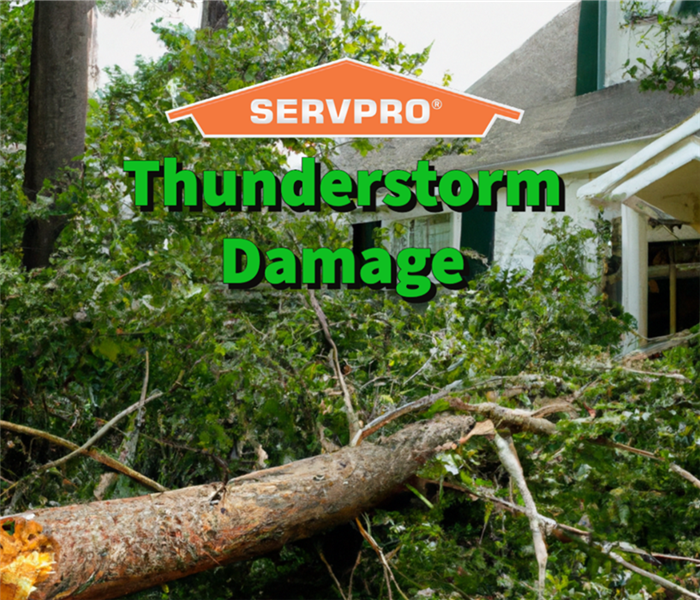 With SERVPRO in your corner, any thunderstorm damage will be restored quickly!
With SERVPRO in your corner, any thunderstorm damage will be restored quickly!
Let’s delve into the essential steps of assessing and repairing thunderstorm damage to your property.
Thunderstorms can unleash powerful forces of nature, leaving behind a trail of destruction. Understanding how to assess the damage and take appropriate action can restore your property and regain peace of mind.
Remember: SERVPRO’s professional services can be a valuable resource in navigating the aftermath of a thunderstorm.
The impact of thunderstorm damage
Thunderstorms can cause significant property damage, ranging from roof leaks and structural issues to water damage and electrical hazards. Therefore, it’s essential to assess the extent of the damage promptly. Doing so can address immediate safety concerns and mitigate potential long-term issues. Some common forms of thunderstorm damage include:
Wind damage:
Powerful winds during thunderstorms can uproot trees, tear off roof shingles, and cause structural damage to buildings. Signs of wind damage may include fallen trees, loose or missing shingles, and structural instability. Therefore, prompt evaluation of wind damage is crucial to prevent further structural compromise.
Water damage:
Thunderstorms often bring heavy rainfall, leading to water infiltration into buildings. Water damage can result in mold growth, weakened structures, and damage to personal belongings. Therefore, identifying and addressing water intrusion areas is vital to preventing further deterioration.
Electrical damage:
Lightning strikes can cause electrical damage, leading to power surges, malfunctioning appliances, and even fires. A licensed professional should inspect electrical systems to ensure safety and identify potential hazards.
Assessing thunderstorm damage
After a thunderstorm, it’s crucial to thoroughly assess your property to determine the extent of the damage. This assessment serves as the foundation for the repair and restoration process. Here are vital steps to consider:
Exterior Inspection:
Start by examining the exterior of your property. Look for signs of roof damage, broken windows, damaged siding, or fallen trees. Take photographs or videos to document the damage for insurance purposes.
Interior Evaluation:
Move inside and inspect each room thoroughly. Check for water stains, wet or damaged walls, ceiling leaks, and compromised electrical systems. Make a detailed inventory of the affected areas and items.
Filing an insurance claim
Once you have assessed the thunderstorm damage, initiating the insurance claim process is essential. Proper documentation and clear communication with your insurance provider are critical to a smooth claims experience. Follow these steps:
Document the damage:
Provide your insurance company with detailed documentation, including photographs, videos, and written descriptions of the damage. This evidence will support your claim and ensure accurate compensation.
Review your policy:
Familiarize yourself with your insurance policy to understand the coverage limits, deductibles, and specific requirements for filing a claim. This knowledge will help you navigate the process more effectively.
Contact your insurance provider:
Notify your insurance company of the damage and initiate the claims process. Maintain clear communication, promptly responding to requests for information or additional documentation.
Property damage restoration
Once you have completed the assessment and insurance claim process, it’s time to focus on property damage restoration. Depending on the severity of the damage, restoration may involve various aspects, such as:
Roof repair and replacement:
Address roof damage promptly to prevent further water infiltration and structural compromise. Engage professional roofing contractors to assess and repair or replace damaged sections.
Water extraction and drying:
If water damage is present, extracting water and thoroughly drying affected areas is crucial to prevent mold growth and further structural deterioration. Professional water damage restoration services can efficiently handle this process.
Structural repairs:
Engage licensed contractors to address structural issues resulting from thunderstorm damage. This may involve repairing weakened foundations, walls, or other compromised structural elements.
4 ways SERVPRO Can Help
When faced with thunderstorm damage and the complex assessment process, insurance claims, and property restoration, SERVPRO is here to provide expert assistance. As a trusted leader in the industry, SERVPRO offers a range of services to support you throughout the restoration journey:
1) Prompt emergency response:
SERVPRO understands the urgency of addressing storm damage promptly. Their highly trained professionals are available 24/7 to provide immediate assistance, mitigating further damage and ensuring the safety of your property.
2) Comprehensive damage assessment:
SERVPRO thoroughly assesses your property, identifying all areas affected by thunderstorm damage. Their expertise allows for a comprehensive evaluation, including hidden damages that may not be immediately apparent.
3) Insurance claim support:
Navigating the insurance claim process can be overwhelming. However, SERVPRO has extensive experience working with insurance companies, and their team can provide valuable support and documentation to facilitate a smooth and successful claims experience.
4) Professional restoration services:
From water extraction and drying to structural repairs and mold remediation, SERVPRO offers a wide range of professional restoration services. Their certified technicians utilize advanced equipment and techniques to restore your property efficiently and effectively.
Let SERVPRO help you recover from thunderstorm damage!
After a thunderstorm strikes, assessing and repairing the damage can be overwhelming. However, with a systematic approach, proper documentation, and professional SERVPRO assistance, you can confidently navigate the challenges.
Remember to assess the damage promptly, file an insurance claim, and engage reputable restoration professionals to restore your property to its pre-storm condition. Then, with SERVPRO by your side, you can embark on the journey to recovery with peace of mind.
Exterior Storm Damage: 5 Simple Tips To Protect Your Home
4/10/2023 (Permalink)
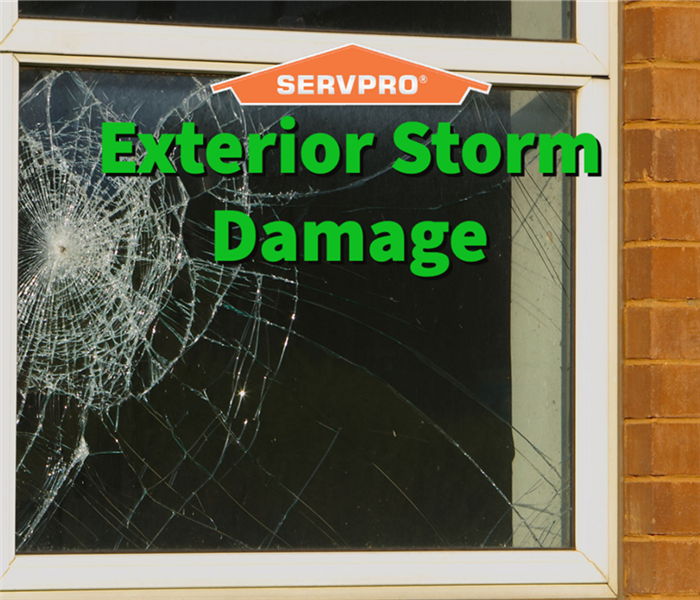 The professionals at SERVPRO are available 24/7 to help you combat storm damage!
The professionals at SERVPRO are available 24/7 to help you combat storm damage!
Exterior storm damage can include anything from broken windows and doors to damaged siding, roofing, and gutters.
Anyone that has lived in the Dayton metropolitan area for more than a month knows that our weather is anything but predictable. In the past five years, we have seen numerous storms that have caused significant damage to homes throughout the area, from tornadoes to severe thunderstorms.
For many residents, the professionals at SERVPRO of East and South Dayton have been the go-to source for repairs and restoration.
SERVPRO knows that storms can be a scary experience, so we want to provide tips on protecting your home from exterior storm damage. However, before we begin: you and your family must have a plan for when a storm strikes. Include storm damage insurance, emergency shelter access, and the necessary personnel contact numbers when severe damage occurs. Now, let’s review how to protect your home from exterior storm damage!
What is exterior storm damage?
Exterior storm damage is the significant destruction to properties caused by incredibly destructive weather that requires repairs. Storms can cause severe damage to many parts of the home, including windows and doors, siding, roofing, and gutters.
SERVPRO’s tips for protecting your home from exterior storm damage
The following tips are essential to keep in mind when protecting your home from exterior storm damage:
- Ensure all of your windows are correctly sealed: sealing the windows in your home will help to keep out excess moisture and strong winds that can cause significant damage to your windows and doors during a storm.
- Install storm shutters: storm shutters are an effective and affordable way to protect your home from exterior storm damage. They provide additional protection for windows and doors during a windstorm or tornado, as they can prevent them from breaking completely.
- Inspect your roof: regularly inspecting your roof will help you identify any potential issues that may need to be addressed before a storm strikes. Ensure your roof is secure and free of any damage caused by strong winds or other exterior storm damage.
- Clean gutters: cleaning your gutters regularly will help ensure that they are free from debris, which can cause water buildup and saturation during storms, resulting in exterior damage.
- Check your siding: self-inspection of the siding on your home for any signs of damage that may need to be addressed before a storm hits helps ensure water doesn’t have an entry point.
In closing, exterior storm damage can devastate homes in the Dayton area. However, by following these tips and having a plan, you can ensure that your home is adequately prepared and protected from potential exterior storm damage.
How can SERVPRO help combat exterior storm damage?
Even the most prepared property owner can still experience exterior storm damage when the weather turns. If this happens to you, SERVPRO of East and South Dayton has experienced professionals who are ready to respond quickly to any storm or weather-related damages that may have occurred. Quick action helps prevent water intrusion and mold growth from flooding.
Our storm damage team will inspect your home for potential issues and provide detailed information about the best course of action. We understand that time is essential when repairing exterior storm damage, so our team will work diligently and efficiently to restore your home.
Whether dealing with broken windows or siding damage, you can trust that SERVPRO of East and South Dayton will be there for you every step. We have the experience, expertise, and equipment to restore your home’s exterior to its pre-storm condition.
Contact us today for more information about how SERVPRO of East and South Dayton can help with exterior storm damage.
Storm Damage Inspection: 5 Things to Expect From The Experts
12/26/2022 (Permalink)
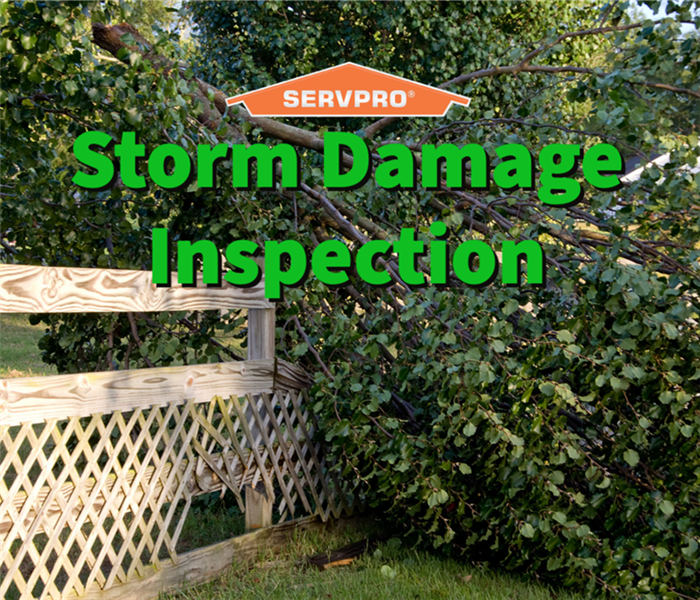 The professionals at SERVPRO are available 24/7 for storm damage inspections!
The professionals at SERVPRO are available 24/7 for storm damage inspections!
A storm damage inspection is essential for property owners after a significant weather event causes property damage.
Residents of the greater Dayton, Ohio, know that unpredictable storms occur all year. With the prevalence of tornadoes, heavy rains, and snow, storm damage to Dayton properties is inevitable. Therefore, knowing how you, a property owner, can prepare for storm damage inspections and what to expect during the process is essential.
The professionals at SERVPRO of East Dayton/ Beavercreek have put together this blog post to help educate property owners on storm damage inspections. We have included a list of five things to expect and some tips to keep in mind regarding storm damage inspections.
Before we begin, contact us immediately if you currently have storm damage on your property and need an inspection. Our storm damage crews are available 24/7 and can respond quickly to your needs.
What is a storm damage inspection?
A storm damage inspection is a process by which a qualified professional assesses the damage to a property affected by a storm. Like a windstorm inspection, a storm damage inspection includes looking for signs of water damage, roof damage, structural damage, and wind damage. The inspector will provide a detailed report of their findings, which you can use to file an insurance claim or get the necessary repairs done.
Five things to expect during a storm damage inspection
Each storm damage inspection is different because the damage's severity will differ from property to property. However, there are five simple things that you can expect during this process:
- Documentation: The inspector will take pictures and document their findings so that you have a record of the storm's impact on your property.
- Advanced tools: A storm damage inspection utilizes specialized equipment to detect water damage behind walls, under floors and other areas that may be difficult to see with the naked eye.
- Questions: They will ask you questions about the storm, such as how long it lasted and what damage occurred.
- Insurance claim help: The inspector will provide a written report of their findings that you can use to file an insurance claim or get the necessary repairs done.
- Preventive tips: Depending on the storm's severity, they may recommend additional repairs or preventive measures to protect your property moving forward.
Preparing for a storm damage inspection
There are some necessary steps in preparation for a storm damage inspection on your property. Here are some tips before your storm damage restoration professional arrives:
- Tip 1: Go through your insurance documents and ensure you have all the necessary information ready for the inspector.
- Tip 2: Take pictures of any storm-related damage before and after it has been cleaned up.
- Tip 3: List any repairs or changes you have noticed since the storm.
- Tip 4: Ask your insurance company if they cover storm damage repairs and if you need anything else to process your claim successfully.
Let SERVPRO of East Dayton/ Beavercreek help you inspect your storm damage.
The professionals at SERVPRO of East Dayton/ Beavercreek are here to help you with storm damage inspections. We understand the importance of having an experienced team assess and document storm-related damage on your property. Our storm damage crews are available 24/7 and provide quality inspection for commercial and residential properties.
We are a highly reputable storm restoration company that also offers various storm-related repair services, such as roof repairs, structural repairs, and water mitigation services. If you need assistance with storm damage repairs, we can help you every step of the way.
Wrapping up
Thank you for reading our blog post on storm damage inspections. We hope this information helps get your property back in shape after a storm. If you need any assistance with storm damage inspections or repairs, contact SERVPRO of East Dayton/ Beavercreek today! We are here to help. ??
Summer Storm Damage: 3 Types of Storms That Cause the Most Damage
7/25/2022 (Permalink)
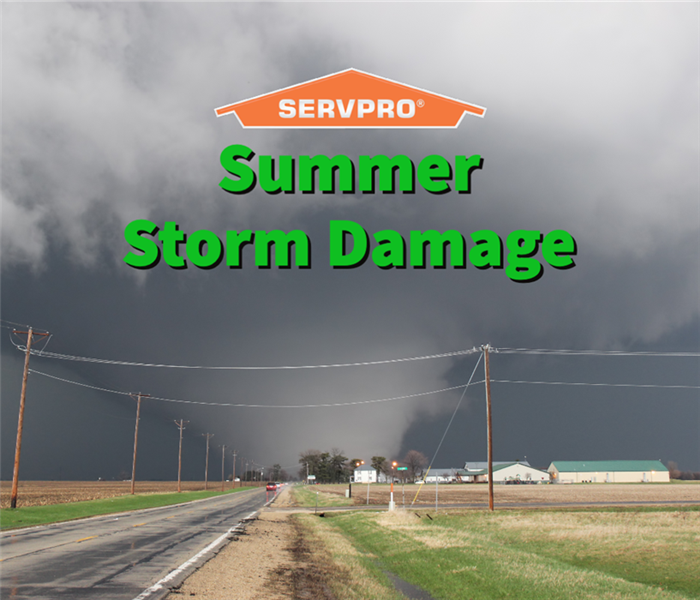 The professionals at SERVPRO are available 24/7 to help restore any property affected by summer storm damage.
The professionals at SERVPRO are available 24/7 to help restore any property affected by summer storm damage.
Recover quickly from summer storm damage with help from the professionals at SERVPRO of East Dayton/Beavercreek!
Summer storms can cause a great deal of damage, both to your property and to your peace of mind. The professionals at SERVPRO of East Dayton/Beavercreek receive an increased number of emergency storm damage calls after summer storms, and we're here to help you recover quickly.
There are three types of summer storms that can cause significant damage:
- Thunderstorms
- Hail storms
- Tornadoes
Each type of summer storm has its own set of dangers, so it's essential to prepare for all three. In the following blog post, we will go over how each type of summer storm can cause damage and why you should contact the professionals at SERVPRO of East Dayton/Beavercreek when you experience any storm damage.
What is summer storm damage?
Summer storm damage refers to property damage caused by a storm in the summer. Summer storm damage can consist of exterior and interior property damage. Whatever the form of summer storm damage, it's essential to take steps to mitigate the damage as much as possible.
One of the main dangers of summer storms is the high winds they often bring with them. These winds can cause tree limbs and debris to fall, damaging property. In addition, summer storms can also cause power outages and flooding.
The three leading types of summer storms cause the most damage.
As we mentioned earlier, the three types of summer storms that can cause the most damage are thunderstorms, hail storms, and tornadoes. In the following sections, we will discuss how your property can become damaged by the three types of summer storms.
Thunderstorms
Thunderstorms are a common type of summer storm that can cause a great deal of damage. One of the dangers that thunderstorms bring to a property is excess rainfall. Rain can cause flooding, damaging your property significantly when not mitigated and restored quickly.
Hail storms
Hail storms are another type of summer storm that can cause significant damage. The hail stones that come down during a hail storm can cause damage to your home's siding, windows, and roof. In addition, hail storms can also cause tree damage and power outages.
Tornadoes
Tornadoes are a type of summer storm that can cause significant damage. Tornadoes can cause damage to your home's structure, as well as downed trees and power lines. The professionals at SERVPRO have dealt with the aftermath of tornado damage and know the importance of quickly mitigating and restoring summer storm damage.
Protecting your property from summer storm damage
Summer storms can cause significant damage to your property, so it's essential to take steps to protect it. Here are a few tips to help you protect your property from summer storm damage:
- Keep valuables in a safe location.
- Clear your gutters and downspouts.
- Trim tree limbs.
- Secure outdoor furniture.
- Have a storm damage mitigation and restoration plan in place.
How the professionals at SERVPRO of East Dayton/Beavercreek can help after summer storm damage?
If you've recently experienced any summer storm damage, the professionals at SERVPRO of East Dayton/Beavercreek can help. We have the experience and resources to mitigate the damage and help you get your life back to normal.
We understand that summer storms can be unpredictable and cause significant damage. That's why we're here to help you 24 hours a day, seven days a week. We're dedicated to responding immediately to summer storm damage emergencies and will work quickly to restore your property back to its pre-storm condition.
SERVPRO of East Dayton/Beavercreek is locally owned and operated, so we're already close by and ready to help. In addition, we have a strong storm damage restoration presence in the Dayton area and are prepared to handle any size summer storm damage emergency.
Contact us today to learn more about our summer storm damage restoration services or to schedule an inspection.
The 5 Types of Storm Damage And How to Recognize Them
5/23/2022 (Permalink)
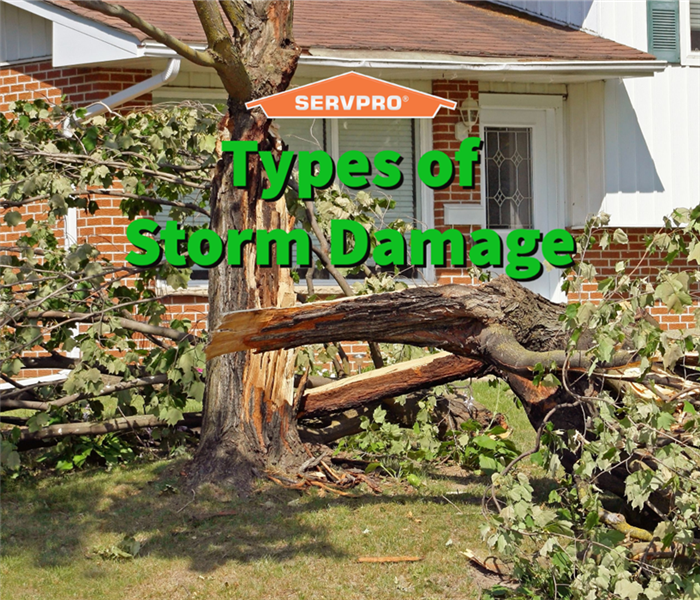 The professionals at SERVPRO are ready for any size storm damage restoration project!
The professionals at SERVPRO are ready for any size storm damage restoration project!
It's essential to identify the different types of storm damage so that you can take the necessary precautions and protect your property.
All year long, the professionals at SERVPRO of East Dayton/Beavercreek receive calls from customers experiencing storm damage to their property. The type of storm damage a property receives commonly depends on the season and the property's location.
There are five types of storm damage that Dayton property owners should be aware of:
- Wind damage
- Hail damage
- Rain damage
- Tree damage
- Snow damage
Each type of storm has its own unique characteristics that can cause serious harm to a property. In this blog post, we will discuss each type of storm in detail and provide tips on recognizing them.
What is storm damage?
Storm damage is any type of damage caused by a severe weather event. The citizens of the Dayton metropolitan area know that storm damage can come in many forms depending on the season.
How to recognize the different types of storm damage
Recognizing storm damage will depend on the type of damage that has occurred. So let's take a closer look at the five different types of storm damage:
Wind Damage
Wind damage occurs when high winds reach up to 50 or 60 mph. These types of winds can cause damage to roofs, windows, doors, and siding. One way to recognize wind damage is by looking for missing shingles on the roof or cracks in the foundation.
Hail Damage
Hail occurs when small bits of ice fall from the sky. These bits of ice can range in size from a small pebble to a large golfball-sized hailstone. Dents in siding or shingles are the most common indication of hail damage.
Rain Damage
Rain damage is caused by, you guessed it, rain! Heavy rains can cause flooding and leaks in roofs, windows, and doors. One way to tell if you have rain damage is by looking for water stains on the ceilings or walls of your property.
Tree Damage
Trees can cause a lot of damage during a storm. High winds can cause trees to fall, damaging roofs, windows, and cars. If you see a tree that has fallen on your property, it is essential to contact a professional to have it removed as soon as possible.
Snow Damage
Snow damage occurs when the weight of snow puts stress on the roof. This type of damage is most common in the wintertime because Ohio receives a lot of snowfall. One way to tell if you have snow damage is by looking for cracks in the ceilings or walls.
No matter what type of storm has passed, you must be sure to inspect for physical damage to your property right away. Missing shingles or siding, dents in metal surfaces, or cracked or broken windows are all common signs that your property has sustained storm damage.
What to do if a storm damages your property?
If a storm damages your property, it is essential to contact your insurance company and a professional storm restoration company to have the damage assessed and repaired. An experienced team will be able to correctly identify the type of damage and take the necessary steps to fix it.
The restoration professionals should know their way around the insurance claims process to help you get the compensation you need to repair your property.
The severity of the damage will dictate the necessary repairs. Common repairs range from patching a hole in the roof or as complex as rebuilding an entire section of the damaged property.
How SERVPRO of East Dayton/Beavercreek can help
SERVPRO of East Dayton/Beavercreek is a professional storm damage restoration company that has been helping customers in the Dayton area for over 25 years. We provide the highest quality service and customer satisfaction while helping customers get the most out of their insurance claims.
When you choose to contact us, we will dispatch a crew to your location as soon as possible. Our IICRC certified and experienced professionals will work diligently to restore your property to its pre-storm condition.
We understand that dealing with storm damage can be a stressful and overwhelming experience, which is why we will work with you every step of the way to make the process as smooth and stress-free as possible. So, please don't hesitate to contact us today if your property sustains storm damage.
We are always here to help!
The 2 Most Common Gutter Problems
5/16/2022 (Permalink)
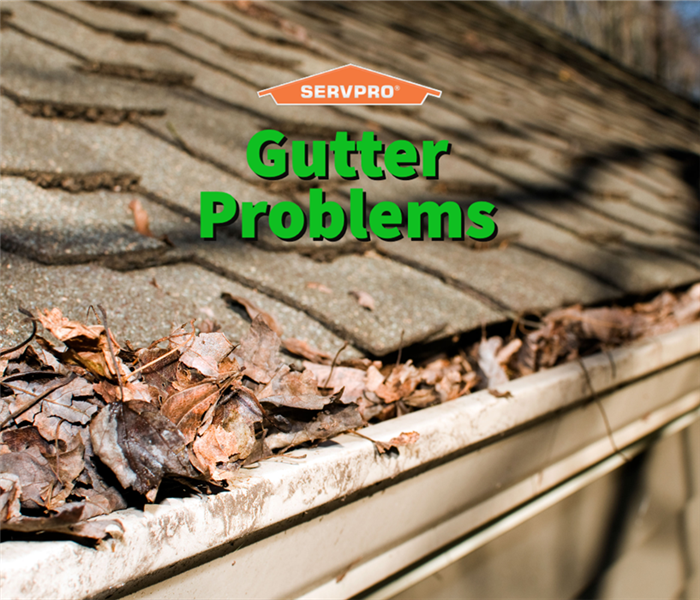 The professionals at SERVPRO are here to help when storm damage strikes!
The professionals at SERVPRO are here to help when storm damage strikes!
Gutter problems need to be addressed before the next storm passes.
It's that time of year again when the weatherman is always predicting storms. And while you're probably worrying about what you'll need to do to prepare your home, you should prioritize your gutters, especially if they are already giving you problems! Gutter problems can be a significant issue, and if it's not fixed before a storm hits, you could be in for a world of trouble.
Your gutters play an essential role in protecting your home from water damage. And the professionals at SERVPRO of East Dayton/ Beavercreek have seen overlooked gutter problems cause severe storm damage.
The following blog post will shine a light on the two main problems with gutters and tips on avoiding them. You can ensure that your gutters function correctly and protect your home from storm damage by taking the necessary precautions.
What are gutters?
Gutters are a type of roofing system that helps divert rainwater away from your home. Without gutters, the rainwater would flow off the roof and down the side of the house, where it could damage the siding, windows, and foundation. Gutters are installed along the roof's edge and have a downspout that carries the water away from the house.
What are the two main problems with gutters?
The two biggest gutter problems are:
- The gutters are not draining
- Clogged gutters
Gutters not draining
A few different causes could lead to a property's gutters not draining correctly. The first could be that the gutters are too small for the size of the roof. When this happens, the gutters can't handle the amount of water coming off the roof, causing an overflow. Another cause of poorly draining gutters could be the downspouts not being installed correctly or being damaged. If the downspouts are not installed properly, the water will not be diverted away from the house correctly and will overflow.
Clogged Gutters
Clogged gutters are another common problem with gutter systems. Leaves, twigs, and other debris can fall into the gutters and block water flow. When this happens, the water has nowhere to go and will overflow the gutters. Clogged gutters can also cause the gutters to pull away from the house, leading to severe damage.
Tips to avoid gutter problems
Whether your property's gutter system has a clog or is overflowing, it's essential to take action to avoid water damage. The following are a few tips on how you can avoid gutter problems:
- Install gutter guards: Gutter guards are installed over the gutters to keep leaves and other debris from falling in and causing a clog.
- Clean your gutters regularly: It's essential to clean your gutters regularly to remove any leaves or debris that may have fallen in.
- Inspect your gutters regularly: Inspect your gutters regularly for any damage or clogs. If you see any damage, be sure to repair it right away.
How can the professionals at SERVPRO help?
We hope this blog post has helped you understand the two main gutter problems. By following the tips mentioned above, you can avoid gutter problems and keep them in good working condition. However, if you experience any water damage due to a faulty gutter system, the professionals at SERVPRO of East Dayton/ Beavercreek are here to help.
All of us here at SERVPRO of East Dayton/ Beavercreek are highly trained and experienced in storm damage restoration. We have the knowledge and equipment to quickly dry out your property to prevent further damage. Our IICRC-certified firm also can work with your insurance company to make the claims process as smooth as possible.
If you have any questions or would like more information, please feel free to contact us at any time. We are always here to help!
Spring Showers: 5 Tips to Avoid Water Damage to Your Property
4/11/2022 (Permalink)
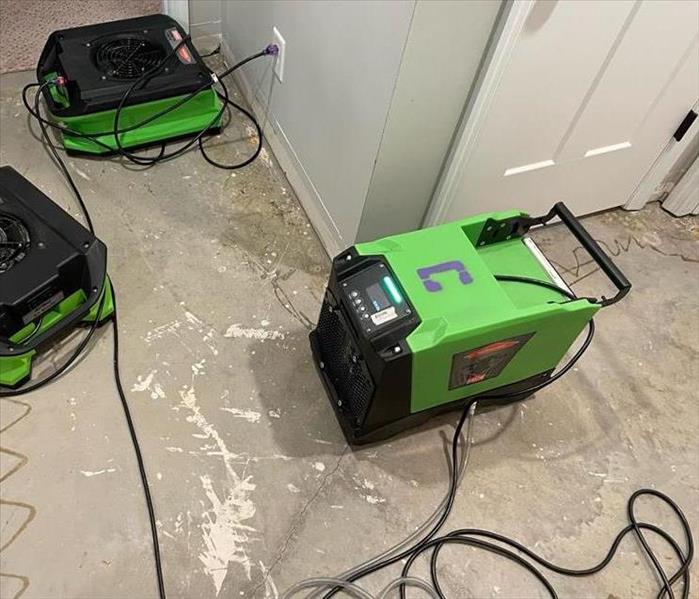 Contact the professionals at SERVPRO for emergency storm damage services!
Contact the professionals at SERVPRO for emergency storm damage services!
Spring showers bring May flowers, but they can also cause water damage to your property if you're not careful.
It's that time of year again: the flowers are blooming, the sun is shining, and the rain is pouring. Spring showers can be beautiful, but they can also cause severe damage if you're not prepared.
As the spring showers start to come in, it's time to start thinking about how to avoid water damage to your property. Spring is a time when the weather can be very unpredictable, so it's essential to take some precautions to protect your home or business.
This blog post will discuss five tips that will help you avoid water damage during the spring months. Follow these tips, and you'll be able to protect your property from the damaging effects of spring showers!
The risks associated with water damage
Water damage can cause several severe problems in your home or business. Some of the risks associated with water damage include:
- Foundation damage
- Basement floods
- Mold and mildew growth
- Electrical system damage
- Structural damage
If you experience water damage after a spring shower, it's essential to take steps to address the problem as soon as possible. The longer you wait to address the issue, the worse the damage will become.
5 Tips to avoid water damage during spring showers
Now that we've discussed some of the risks associated with spring showers, let's talk about avoiding water damage.
Here are five tips that will help you keep your property safe from water damage:
- Inspect your gutters and downspouts regularly
One of the best ways to avoid water damage is to ensure that your gutters and downspouts are clear and in good working condition. Clogged gutters can cause water to back up and pool around your foundation, leading to severe damage.
- Keep an eye on the weather forecast
Another way to avoid water damage is to keep an eye on the weather forecast. If you know that a spring storm is coming, take steps to protect your property in advance.
- Move all valuables to higher ground
If you live in an area prone to spring floods, make sure to move any valuables to higher ground in advance. Placing items even a foot above ground level will help protect your belongings from water damage.
- Create a barrier around your property
If you live in an area prone to spring flooding, you may want to consider creating a barrier around your property. This barrier can consist of sandbags or other materials that will help to keep water away from your home or business.
- Call a professional when you experience water damage
If you experience water damage, it's essential to call a professional as soon as possible. A professional water restoration company can help to assess the damage and take steps to repair it.
Wrapping up
We hope you enjoyed this blog post and found it helpful. Water damage can be a severe problem, but it's one that you can avoid when prepared. Following the tips mentioned in this blog post will help you avoid water damage during spring showers. However, if you do experience water damage, it's essential to call a professional as soon as possible to help repair the damage.
SERVPRO of East Dayton/Beavercreek is an IICRC certified firm that understands the importance of proper water damage restoration. Our certified technicians are available 24/7 to help you with any water damage emergency.
The team at SERVPRO of East Dayton/Beavercreek is always here to help when you experience water damage. Contact us today, and we'll be on our way to help you restore your home or business!
5 Great Steps to Handle Winter Storm Damages
1/24/2022 (Permalink)
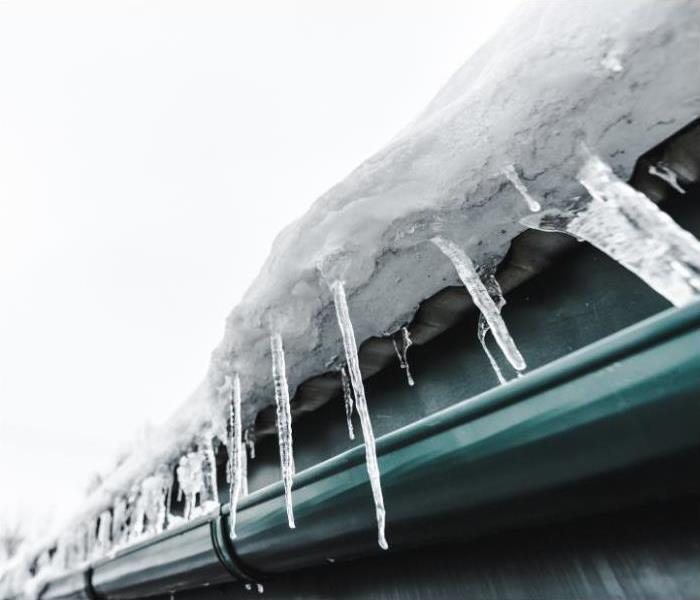 Contact the storm damage cleaning professionals at SERVPRO for superb services!
Contact the storm damage cleaning professionals at SERVPRO for superb services!
The winter storm damage cleanup can be long and arduous without professional help.
Winter storms can cause a lot of damage to residential and commercial properties. The professionals at SERVPRO have seen high winds, snow, and ice can all wreak havoc on Dayton homes and businesses every year. Suppose you are unfortunate enough to experience winter storm damage this winter season; in that case, it is crucial to take the necessary steps to protect your property and get things back to normal as quickly as possible.
This blog post will discuss five steps that a property owner should take when experiencing winter storm damage. These five steps will help anyone handle the winter storm damage situation as smoothly as possible.
Winter storm damage can cause the following types of property damage:
- Water damage: Flooding can occur when ice dams and snow accumulate, block storm drainage paths, and overflow onto your property. If flooding results from winter storm damage, the best thing you can do is remove standing water as quickly as possible before it can cause further damage.
- Wind damage: High winds associated with winter storms can easily take down trees and limbs. The debris from these trees and limbs can damage the storm gutters, roofing system, windows, siding, or shingles.
If you're unlucky enough to experience these two typical winter storm damages to your property, don't worry! We've put together five steps to help you handle the situation as smoothly as possible.
Step 1: Ensure safety
Safety is an essential part of the winter storm damage cleanup. Therefore, ensure your safety and the safety of your family members before doing anything else.
Winter storms can cause trees and branches to fall, which puts anyone in its path at risk. Please stay away from damaged or broken power lines, and report them immediately to your power company. Lastly, if there is any danger of the structure collapsing, make sure to evacuate the area.
Step 2: Turn off electricity and water sources
If winter storm damage occurs to your home, make sure to turn off electric or water sources before making any repairs. If you are not familiar with how to shut off electricity or water sources, then call an electrician and plumber.
Step 3: Assess the damage
The third step is to assess the damage. Make a list of all the damage that has been done and take pictures or videos of the damage. Documenting the damages will help you file a claim with your insurance company.
Step 4: Contact your insurance company
The fourth step is to file a claim with the insurance company as soon as possible after winter storm damage occurs. A property owner will want to contact their insurer as quickly as possible to begin repairing the damages. Be sure to keep all receipts and repair estimates as you will need this information to help with your claim.
Step 5: Contact a trusted restoration contractor.
It will be worth contacting a trusted restoration contractor to help with repairs. They can help you make a plan for winter storm damage cleanup and even give you a restoration estimate on the costs of repairing winter storm damage.
Final thoughts
We hope this blog post has helped answer any questions about winter storm damage. We are currently in the winter storm season, so be sure to keep these tips in mind until spring comes around!
Please get in touch with the team at SERVPRO of East Dayton/Beavercreek for any winter storm damage cleanup and restoration services! Our crews are local and available 24 hours a day, 365 days a year, to assist with winter storm damage cleanup.
Siding Storm Damage: The #1 Guide In Dealing With Siding Damage
12/13/2021 (Permalink)
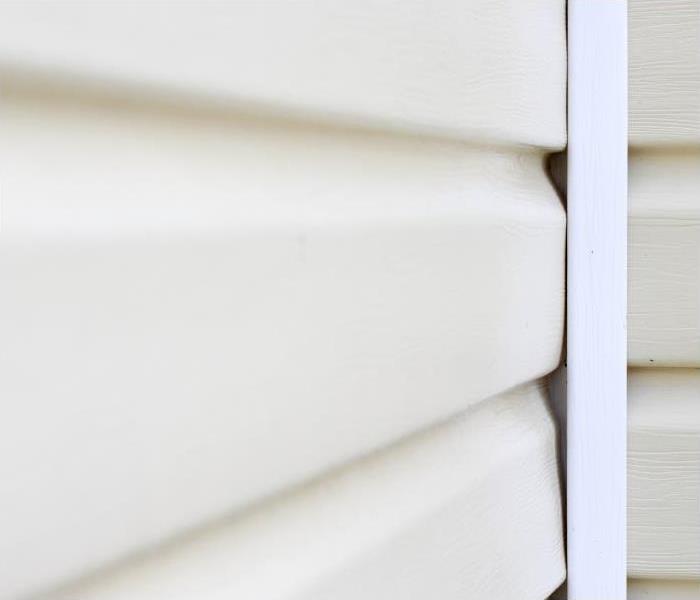 Contact the professionals at SERVPRO for seamless siding storm damage repairs!
Contact the professionals at SERVPRO for seamless siding storm damage repairs!
Siding damage is typical after a heavy storm passes through Dayton, Ohio.
Siding is an aspect of construction that has undergone a revolution in the last few decades. As a result, siding materials are different, installation methods have changed, weather resistance has improved, and even siding styles have adapted to the times. For homeowners, this means better protection against storms, heat buildup, and moisture accumulation, among other potentially damaging factors.
Although siding damage technology has improved, siding storm damage can still occur. Depending on the extent of siding damages after a storm event, there are several ways homeowners can go about fixing their siding storm damage. The following blog post will cover the different types of siding storm damage and steps for repairing and restoring siding.
5 Steps in responding to siding storm damage
Here in the greater Dayton, Ohio area, there are three common types of siding storm damage:
- Wind damage
- Hail damage
- Rain/moisture damage
No matter the cause of the damaged siding, it's essential to adhere to the following steps to prevent further damages:
Step 1: Assess the damage
Anytime siding is damaged, you need to understand the extent of siding storm damage. After the storm has passed, a property owner will want to assess the extent of the damage and take pictures for insurance claim purposes. Common signs of siding storm damage include:
- Missing or broken siding panels
- Cracked, warped, or split siding
- Damaged flashing and trim
- Home water infiltration
Step 2: Review your coverage
After assessing the siding storm damage, take time to review your property insurance coverage. The last thing you want is to file a claim and have it not covered by the insurance policy. However, it is likely that a total replacement covered by the insurance company will occur, even if only a portion of the siding was damaged.
Step 3: Choose the right contractor.
Many contractors and companies will want to help with property damage repairs. Choosing the right contractor may be tricky, but you will want to ensure that the company you choose knows how to develop a restoration insurance estimate. Unfortunately, not all contractors know how to handle siding storm damage insurance claims!
Step 4: File an insurance claim
After choosing the right restoration contractor, you can then move forward and file a siding insurance claim. The property claims adjuster will review and analyze the siding insurance claim and estimate. As a property owner, you may not have to do much during this step because the right restoration contractor will mediate between you and the property insurance company.
Step 5: Create a future prevention plan
You will want to create a storm damage prevention plan after the storm damage is repaired and the siding is back to its preloss condition. A storm damage prevention plan will allow you to become proactive when severe weather conditions come into the area. A storm damage prevention plan should include:
- Removing dead tree limbs that are close to the property.
- Clearing gutters of debris every few months.
SERVPRO is the #1 best siding storm damage company
Depending on the severity of the siding storm damage, siding may need to be eradicated to mount a total replacement. However, that is not an issue for the professionals here at SERVPRO of East Dayton/Beavercreek. Our professionals are capable of handling any extent of siding storm damage. We have a long history of experience in dealing with siding damage, and our team knows how to properly restore siding to its original condition, all while coordinating with your insurance company.
SERVPRO of East Dayton/Beavercreek is a leading restoration contractor serving Dayton, Ohio, and surrounding areas. As an IICRC certified firm, we are experts in all types of property restoration claims and are available 24/7 for emergency services. If you have siding storm damage or any other kind of damage, contact us today for a consultation!
Fallen Tree Damage: 5 Steps to Take When a Tree Damages Your Property
8/23/2021 (Permalink)
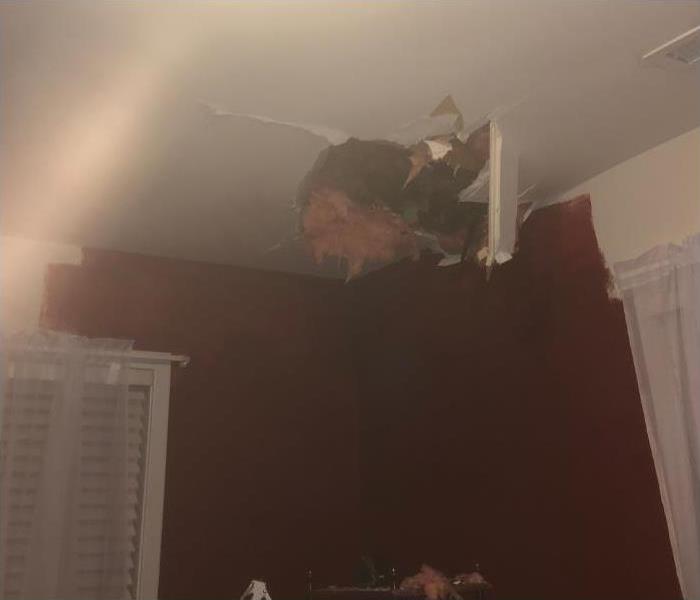 Contact the professionals at SERVPRO for fallen tree restoration services!
Contact the professionals at SERVPRO for fallen tree restoration services!
The damages done to your property by a fallen tree may be covered by insurance.
You are very fortunate if a fallen tree has never damaged your home. The sound of a tree crashing onto your property is terrifying, and the aftermath can be even scarier. Fallen trees often result in damage to homes, cars, fences, and other structures on your property.
The following blog post will go over when insurance covers fallen tree damage to a property and the steps to take when a tree has damaged your home.
Recent fallen tree damage project
Those that live in close proximity to Dayton, Ohio, know how prone our homes are to tornado damage and wind damage. Every time high wind speeds pass through the Dayton area, our SERVPRO professionals receive numerous calls regarding exterior damages.
The most recent wind storm occurred in April and left one homeowner with serious damage after a fallen tree crashed into their roof and left a hole in their family room ceiling.
When we arrived at the damaged home, we evaluated the damages done and began to design a plan to remove the tree and protect the home from further damages. Fortunately, it was not raining when the tree fell, so water damage restoration services were unnecessary.
Within a few hours, our professionals removed the tree from the roof, and we used a secure tarp to cover the hole in the roof. Then the homeowner submitted a claim to their insurance company, who said they would cover the fallen tree damages done to the home.
In the end, the homeowner received a brand new roof and was delighted with our services, and let us know that they would be using us for future home restoration services.
When is fallen tree damage covered?
Fallen tree damage will be covered by an insurance carrier when covered perils are damaged by wind. Covered perils include damages including your home or other structures such as a shed or a fence.
Suppose a fallen tree damaged the property due to negligence on behalf of the homeowner. In that case, the homeowner will be held liable for the damages, and an insurance carrier will likely not cover the damages.
5 Steps for fallen tree damage
When it comes time to clean up after a fallen tree has damaged your property, there are five steps you should take:
Step 1: Evacuate everyone from the property. After a fallen tree damages your home, you will want to ensure that everyone that resides in the home is safe.
Step 2: Document the damages done to the property. Before any work is done, you will want to document all damages to the property for insurance purposes. You should take pictures and videos and create a list of any personal belongings that were damaged.
Step 3: Contact a local restoration contractor. Local restoration contractors like those at SERVPRO of East Dayton/Beavercreek will mitigate fallen tree damage quickly and professionally.
Step 4: Contact your homeowner's insurance provider. The sooner that you contact your homeowner's insurance provider, the quicker the repairs will occur.
Step 5: Ensure your property is secure from further damages. The damages done to your property should be covered by a roof tarp to ensure no water or pests make their way into your property.
Fallen tree damage restoration
The professionals at SERVPRO of East Dayton/ Beavercreek specialize in restoring properties after a fallen tree causes damages. All of our SERVPRO professionals are IICRC certified and are available 24/7, rain or shine.
SERVPRO of East Dayton/ Beavercreek even has a construction division to repair or rebuild any damages that occurred to your property. So when you contact us, you will receive tailored services from the best restoration team in Ohio.
5 Actions To Take When a Basement Floods
6/21/2021 (Permalink)
 Contact the basement flood clean-up professionals at SERVPRO for quick services!
Contact the basement flood clean-up professionals at SERVPRO for quick services!
It's better to be overly prepared for basement floods.
In and around greater Dayton, Ohio, local residential and commercial properties are prone to basement flood damage caused by heavy rainstorms. In a previous blog post, we went over flood prevention tips to help the Dayton locals prepare for basement floods. This blog post will go over what a property owner can do immediately after a basement flood.
If you are currently in the middle of a basement flood, your best course of action will be to shut off all electrical power to the house and contact the professionals at SERVPRO for fast action services.
5 Actions when dealing with a basement flood
- Keep children and pets away from the flooded basement.
- Remove all contents and wet materials
- Extract all water
- Dry the basement
- Apply an antimicrobial
1) Keep children and pets away from the flooded basement
When dealing with a flooded basement, it is best not to allow children or pets to enter the flood-damaged area. Basement floodwater from rain is categorized as category 3 water damage by the IICRC due to the highly contaminated water present. Ony an individual wearing the proper (PPE) personal protective equipment should enter a flooded basement.
2) Remove all contents and wet materials
Only after you have on the PPE can you consider removing all of the salvage and unsalvageable items. To effectively and quickly dry a flooded basement, all category 3 waterlogged items must be thrown away, and all salvageable items should be placed in another area of the home.
If your basement has a lot of content, you will want to get a professional pack-out. A pack-out is where contents are taken to an offsite location for storage and cleaning. In most cases, an insurance company will compensate the property owner for the unsalvageable damaged items and the cost of the pack-out.
You should also remove all of the flood-damaged floorings throughout the basement. Water that sits in carpet flooring can cause mold on the carpet, and water-damaged hardwood flooring will warp.
3) Extract all the water
After all of the damaged contents are removed from the flooded basement, you can begin the water extraction process. The best way to extract water from a flooded basement will be by using a truck-mount water extractor. Our SERVPRO truck-mount water extractor is designed to hold over sixty gallons of extracted water.
Quickly removing all floodwater from a basement is essential in the restoration process because a damp, dark environment is a great place for mold to grow easily.
4) Dry the basement
The only way to ensure that a basement flood is completely dry will be by using industrial fans and dehumidifiers. These two pieces of restoration equipment work in conjunction with one another. The fans will move the water particles into the air while a dehumidifier removes all the excess moisture.
5) Apply an Antimicrobial
Applying an antimicrobial to a water-damaged area stops the growth of mold. The antimicrobial solution SERVPRO uses has proven to kill and slow the spread of microorganisms found in floodwaters.
Skip all steps and call SERVPRO
The professionals at SERVPRO of East Dayton/Beavercreek receive many calls a year where a customer attempts to restore their flooded basement on their own and then discovers mold weeks after. Unfortunately, mold damage will be more expensive than flood mitigation, especially when mold spreads to other areas of the property.
Our goal is to quickly restore your flooded basement and to ensure it doesn't flood again. That is why, when SERVPRO arrives at a flood damage situation, an IICRC certified professional starts by finding out what caused the basement flood in the first place. For example, most basement floods in Dayton result from a sump pump failure; if this is the case, it would be wise to purchase a new sump pump ASAP.
Contact us today if you need basement flood restoration services. SERVPRO of East Dayton/Beavercreek is available 24/7, 365 days a year!
6 Steps to Recovery After A Storm Damages Your Rental Property
6/14/2021 (Permalink)
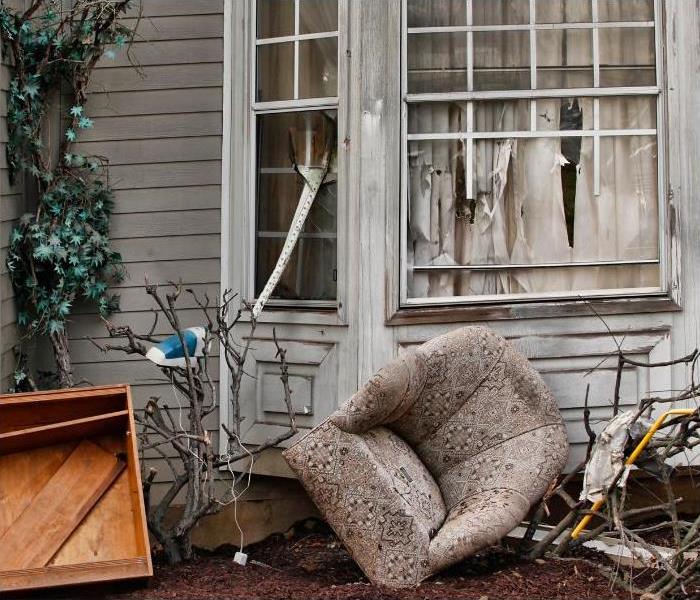 Contact the storm damage professionals at SERVPRO for mitigation and restoration services.
Contact the storm damage professionals at SERVPRO for mitigation and restoration services.
Storm damage to a rental property is a landlord's worst nightmare.
It is hard enough to deal with storm damage on your property, but what about storm damage to the rental property you own? Whether it was a tornado or hurricane that caused the storm damage, there are steps to take to ensure you and your tenants recover quickly. This blog post will give you six simple steps that will help your property recover after being damaged by storms.
The responsibility of the landlord
Storm damage to a rental property will likely occur when the property is in an area at high risk for storm damage. The team at SERVPRO of East Dayton/Beavercreek knows that landlords are at greater risk for Dayton tornado damage. Therefore, before the next tornado passes, it is a good idea to go over tornado preparation tips with your tenants.
When a tornado passes and causes storm damage to a rental property, a Dayton landlord must be mindful and courteous to their tenants and repair storm damage immediately. If the damage has made the property uninhabitable, it may be the landlord's responsibility to provide temporary housing for their tenants, depending on the lease agreement.
6 Steps to recovery
- Communicate with your tenants
- Contact your insurance company
- Keep track of damaged contents
- Get the damages professionally assessed
- Prevent further damages
- Restore the property
1) Communicate with your tenants
After a storm passes the area of your property, you need to be in communication with your tenants and check if they are safe, and then ask about property damages. The extent of the storm damage to a rental property may be uninhabitable and require temporary housing, which can be reimbursed through renters insurance or the American Red Cross.
Your tenants are counting on your support; it would be a good idea to advise them to contact their rental insurance company immediately.
2) Contact your homeowner's insurance company
Whenever there is storm damage to a rental property, we recommend that the property owners contact their homeowner's insurance company ASAP to let them know what happened. Your homeowner's insurance company will advise you on how you should move forward.
If you live in your rented property, the storm damage to the rental property may be "unfit to live in," and you will receive a reimbursement for temporary housing. A homeowners adjuster will determine if a home is unsafe after a severe storm on a case-by-case basis.
3) Keep track of all damages
When your property is safe to enter, it is essential to track an accurate list of your losses. You can create a list on Google Sheets or Microsoft Excel. While creating the list of damages, you should also be taking pictures and videos for insurance claim proof. A list that tracks storm damage to a rental property needs to include the following:
- Structural damages
- Damaged electronics
- Damaged furniture
- Damages cabinets
- Damaged flooring
- Broken windows
- Roof damage
- Wall water damage
- Ceiling water damage
- Standing water
- Signs of mold damage
4) Get the damages professionally assessed
After communicating with your tenant and ensuring that they are safe, you need to have a professional team come out to assess the storm damages to the rental property. We suggest assessing the property even when there aren't any apparent damages because storm damages to a roof are sometimes not noticeable until months after the damages occurred.
5) Prevent further damages
Securing the property is the best way to prevent additional storm damage to a rental property after a storm passes. You can secure a rental property by covering open holes in the roof or walls with plastic sheeting.
6) Restore the property
After storm damage to a rental property occurs, you will want your property to be restored by a reputable restoration company. Water damage to a rental property will require mitigation services to dry out the property. Once the property is dry, the rental property may need new drywall, insulation, and paint.
Contact SERVPRO for storm damage services.
The professionals at SERVPRO of East Dayton/Beavercreek have seen it all when it comes to emergency damages, and storm damage to a rental property is no exception! When you contact our Dayton storm damage team, you will quickly have a team of IICRC certified professionals that take pride in delivering quality work.
We have over sixty years of experience working with insurance claims and are ready to help you get a fair amount on your rental property insurance claim. From exterior to interior damage, we understand no repairs can wait. Contact us today for any further questions or emergency services regarding rental property storm damage.
5 Essential Tornado Property Preparation Tips For Dayton Locals
5/10/2021 (Permalink)
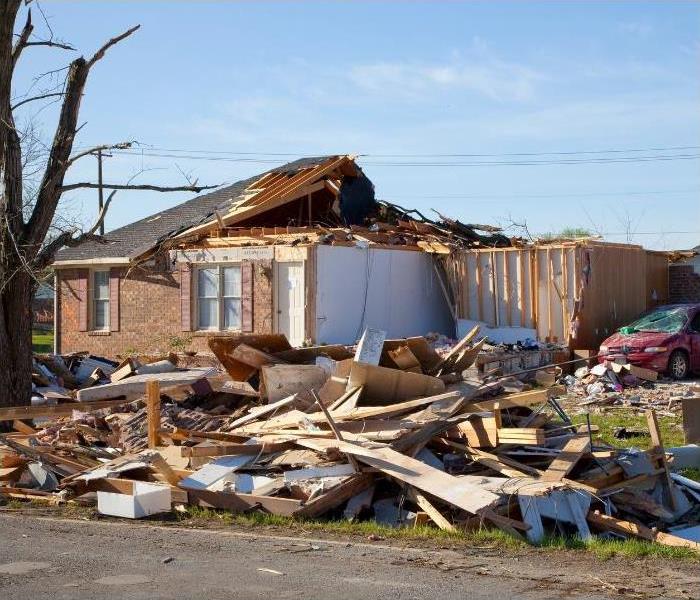 Contact the professionals at SERVPRO for more information on our tornado repair services!
Contact the professionals at SERVPRO for more information on our tornado repair services!
A tornado property preparation plan will limit the number of damages.
Tornadoes are the most dangerous of all atmospheric storms. They can demolish well-built buildings, uproot trees, even hurl items into the air like lethal missiles. Strong tornadoes can strike anywhere in the greater Dayton area. The locals of Montgomery County know how the month of May in 2019 was by far the worst tornado season seen in the last few years.
Tornadoes are unpredictable, but with the start of spring, it's vital to keep ahead of the game so you'll know what to do if one hits the ground. To be tornado-ready, you must understand what to do before, during & after a tornado hits. Keep reading and learn what you can do to keep your loved ones and property safe.
Plan for the worst, hope for the best
The first step when it comes to tornado preparation is to have a plan. After you have finalized all of your tornado preparation plan details, it is essential to explain the plan to your loved ones so they know what to expect in a tornado emergency. Your well-thought-out tornado preparation plan will alleviate any last-minute panicking because you will know what to do and where to go when you have a tornado property preparation plan in place. Consider the following when creating a tornado property preparation plan:
- Determine a secure location in your home where family members and pets can safely go to. The best place to seek shelter will be on your lowest floor and avoiding windows. A basement or storm cellar is the safest option.
- If in a high rise, choose a hallway in the building's center as a secondary option in case there is not enough time to go to its lowest level.
- Choose a secure location in a nearby stable building if you live in a mobile home. During a tornado, no mobile home, no matter how well-built, is safe.
The 5 tornado property preparation tips
Preparing your home for a tornado is essential for the safety of your family and property. The following property preparation tips will help you limit the amount of damage:
- Trim trees with diseased or decaying branches and limbs. Loose tree branches will shatter windows, garage doors, and roofs, causing severe harm to your house.
- Prepare a list of anything that has to be taken indoors in the event of a tornado storm, including furniture, toys, bins, tools, trailers, cars, swings, and everything else that can be picked up and tossed by heavy winds.
- Clear the yard of debris – branches & firewood will become missiles in strong winds.
- Your garage doors should be secured shut. In certain houses, a garage is a vulnerable spot. The impact from the wind will raise the roof off the house if your garage door is breached.
- Install storm shutters to cover and protect windows.
When to expect a tornado in Dayton?
In Dayton, Ohio, every month is in tornado season, but the risk of a tornado is highest in late spring and early summer (April to July). More than half of the tornadoes that have struck the state since 1950 have occurred in May, June, and July. According to data from the National Oceanic & Atmospheric Administration.
Signs of a tornado
- The sky will be black and slightly greenish.
- Air will become very still before a tornado arrives.
- There is a loud roar, close sounding to that of a freight train.
- An approaching cloud of debris, even when the funnel is not visible.
Who to call tornado damage repairs
Your property may have been severely damaged even after you follow the tornado property preparation tips listed above. Although your property may need restoration services, we are happy that you have made it out safely.
You can trust the IICRC certified team of professionals at SERVPRO of East Dayton/Beavercreek for quick and reliable tornado property repair services. Our local crews know how devastating tornado damage can be and want to help you every step of the way. Contact us today for more information on how we can help you with your homeowners insurance claim and restore your property!
Dayton Ice Storm Cleanup Professionals
2/22/2021 (Permalink)
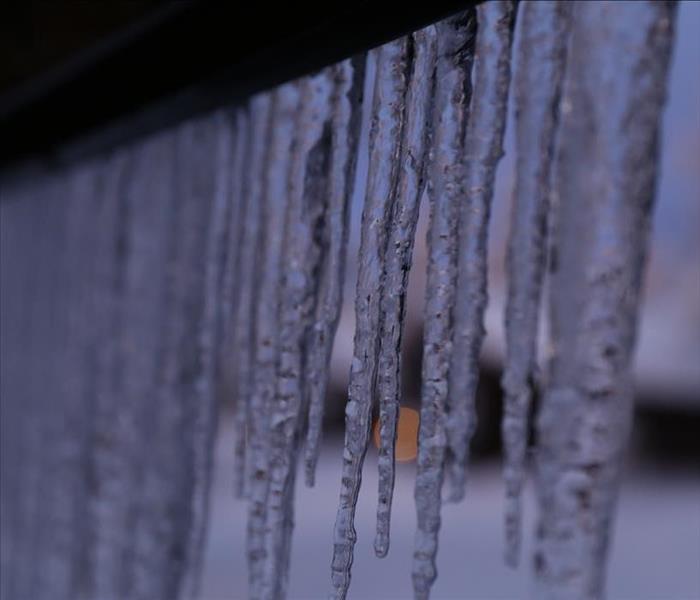 Heavy ice dams can cause severe damages to your property.
Heavy ice dams can cause severe damages to your property.
An ice storm can turn your everyday life upside down.
Many unpredictable weather events can take place in the early spring and late winter. An ice storm is often caused by a combination of warm and cool air. Heavy ice or snow can result in unique problems and cause severe damage to properties. Take action immediately to prevent further damages.
If you're wondering what to do when mother nature decides to bring ice instead of snow, then read on. Let's help you figure out the problem and understand how our experts at SERVPRO of East Dayton/Beavercreek can mitigate the issue for you!
Storms in Dayton Ohio
Dayton experiences challenging weather conditions such as tornadoes, ice storms, wind storms, floods, and other disasters. Heavy ice can cause carports, porches, roofs, and other outdoor buildings to collapse.
During an ice storm, you may experience:
- Large tree branches collapsing on your property.
- Freezing and bursting pipes.
- Electricity outages
When your property is damaged from an ice storm, you need a team of experts with winter storm experience. At SERVPRO, we understand how vital cleanup and restoration after a disaster can be. Our professionals have state-of-the-art tools and resources to restore your property to a pre-disaster state.
How to recover your property following an ice storm?
Damage from an ice storm is inevitable; your property will somehow end up affected. The city of Dayton experiences harsh weather conditions every now and then; locals should always be prepared for natural disasters. However, it is understandable that one can only do a little by himself. Before calling professional help, you can still take some steps to recover your property from ice storm damage. Starting from inspecting your property and surrounding area for damage like:
- Downed tree branches and powerlines; It is dangerous to mitigate damages by yourself. It is best to call for professional help.
- Ice buildup on roofs, driveways, and sidewalks.
Treat sidewalks and driveways
Accumulated ice on driveways and sideways can be extremely unsafe for residents, visitors, and mail carriers. Treat all driveways and pathways with salt to thoroughly melt the ice as soon as possible.
To minimize the buildup of ice, you could also add salt or an ice melting product to driveways and sidewalks before the storm. Nevertheless, it is essential to remember that you may still have to apply additional ice melt products after the storm.
Check for ice build-up on the roof
Ice buildup on roofs can cause a lot of problems. Following an ice storm, be extra cautious of the amount of ice on your roof and whether or not your roof is capable of supporting extra weight. Ice is dense and heavy; weakening or even collapsing under the added weight is not unusual for a porch or roof.
If the ice build on your roof is becoming concerning, you should call a qualified Dayton roofing contractor to melt or remove the ice. Property owners should never try to clear ice from their roofs themselves; it is unsafe.
Similarly, ice dams are caused by ice that builds up at the roof's edge, collecting water or melting snow behind it. An ice dam will stop water from flowing off a roof. A common effect of an ice dam is water damage after the water backs up under shingles and into your property. If the water damage goes unnoticed, it will result in mold growth and interior water damage.
Check the trees on your property
A severe safety issue can occur from ice on tree branches. The weight of accumulating ice can not only pull down branches on people, but it can also destroy vehicles and properties. For this purpose, surveying trees from a reasonable distance is necessary. Do not try to trim the tree yourself; always call for professional help.
Does insurance cover ice damage?
The purpose of insurance is to cover you from property losses. Sadly, insurance providers won't be paying for everything. Let's look at what is typically covered in ice storms.
- Many insurance plans do not include the loss of debris from trees unless the tree has fallen on a building or house.
- Your insurance provider will be liable for paying the damage if your neighbor's tree falls on your business or house.
- In these cases, insurance providers usually compensate property damage if trees crash through windows or collapse on roofs.
- If water damage occurs from frozen pipelines that burst, the damage is generally covered by your home insurance claim.
Contact SERVPRO today!
Our experts are skilled and can handle all types of ice damage disasters. We are an IICRC certified firm and have a proven track record of providing quality mitigation, restoration, and reconstruction services. Call us today! We are available 24/7!
How To Identify Hail Damage
1/11/2021 (Permalink)
 One-inch sized hail balls will cause significant damages.
One-inch sized hail balls will cause significant damages.
Hail Damage Affects Many Homeowners
A storm that brings hail up to one inch in diameter is sure to deliver hail damage to your roof. You can count on there being severe roof damage if the hail is combined with high wind speeds. To identify hail damage to your property, look for structural destruction signs such as cracks or broken windows, dented siding, or damaged gutters.
Be mindful that small-sized hail balls can cause some hidden damages to your roof, so it is essential to contact restoration storm damage specialists for hail damage. Storm restoration specialists know how to inspect your roof after you get hit by a hailstorm, whatever size the hail may be.
When hail strikes Dayton and surrounding areas, almost all homeowners will be affected by hail damage, either with more prominent or minor destruction to their property. Take into consideration that hail storms are unpredictable and can happen at any time of year. Without knowing the signs of storm damage, it will be difficult to determine how much damage a hail storm has done to your roof.
Signs of hail damage
Hail damage can cause minor to major types of damages on your roof. It can crack or even shatter tough materials on the roof like shingles, clay, or concrete. While severe damages can be easy to spot, some more complicated issues can only be detected by a professional eye. Some common types of hail damages we see on roofing are:
- Dark patches
- Granules loss
- Bruised shingles
- Dents
- Broken ends of shingles
- Splits on shingles
Hail damage insurance claim
Before contacting your insurance company and filing a hail damage home insurance claim, it is recommended to hire professional help independently to evaluate the damage that a hail storm has done to your property and roof.
Insurance damage professionals know what kinds of documentation insurance adjusters are looking for and can help you file a claim. After they help you get the claim processed, they will then help with all property damage cleanup. When there is significant damage to your roof, the storm damage professionals will use mitigation tactics to save your home from further damages.
Identifying hail damage
Did you know that a hail smaller than an inch in diameter can cause damage to your property? After a hailstorm hits, evaluating the hail's size can be the simplest way to identify what types of damage your property might have faced. Knowing the size of the hail balls that have damaged your property will be critical in the insurance claim process.
Various assessments are done depending on the hail size, and its damages increase with the increase in hail size.
- ¾" Hail: This is the smallest measured hail, and it can cause considerable damages depending on the speed of the wind. It can damage the vinyl siding, windows, metal fascia, and also deck paint. Missing shingles have also been detected from wind and this size of hail.
- 1" Hail: This size hits hard and will damage shingles and the underlayment of the roof. One inch hail can cause significant damage to gutters, siding, and fascia. High wind speed will cause damage.
- 1 ¼" Hail: The damage is much more than the increase from 1". Even if it is not followed by wind, it can cause significant hail damage.
- 1 ½ Hail: This size may have substantial damage to your property. Depending on the duration, amount, and wind speed, it can result in disasters to your roof.
- 1 ¾- 2" Hail: This size of hail can penetrate the roof and create damage to the underlayment, ridge caps, or even plastic vents. It can tear the siding off the roof, break the windows, and damage many metal fittings.
- 2" Hail: This or higher proportions will cause significant damages to properties. When your property experiences this size hail ball, you need to immediately contact restoration professionals to avoid further damages.
Does insurance cover hail damage?
In short, yes, but when your property undergoes hail damage, it is best to contact restoration contractors immediately to increase the likelihood of getting your insurance claim approved. The quicker you get your roof inspected after hail damage, the more likely you will avoid further damage. SERVPRO of East Dayton/Beavercreek specializes in storm damage and will help with your hail damage repairs and offer insurance guidance. Call us anytime at (937) 228-3433. Our IICRC trained professionals are here to help you, 24/7.
Free 5 Part SERVPRO Checklist For Basement Flooding
9/21/2020 (Permalink)
 SERVPRO is available 24/7 for all emergency services!
SERVPRO is available 24/7 for all emergency services!
This post will evaluate what property owners should consider before, during, and after Beavercreek flooding occurs. As a reputable storm damage restoration company in Dayton, Ohio, we believe that homes damaged by powerful storms should seek assistance from a reputable restoration company to repair the damage.
In Ohio, hazardous weather conditions can cause river flooding, wind damage, ice damming, and floodwater to damage your property. In the winter months, ice damage and hail damage are the leading cause of Ohio storm damage.
5 Part Checklist For Basement Flooding
- Make safety a priority. Before you call your local SERVPRO for water restoration services from flooding, it is essential to check if power lines surrounding your property are down before any storm remediation occurs. Take extra precautions around broken down electrical lines. Please refrain from making contact with any fallen electrical lines. Water is a conductor for electrical currents; a single touch can send high voltage through the human body, causing severe damage.
- Assess your roof for damage. Once storm damage occurs in Ohio, it is essential to have a professional inspect your roof for damage and roof leaks. When a professional gets on site, he will be checking for missing shingles and fallen branches that have hit the roof or gutters. In severe cases, especially in the winter months, hail damage or ice damage can cause holes in the roof of your home. When you call a SERVPRO professional to inspect your roof, it will also be useful to have the professional evaluate the property for any other potential damages like frozen pipes.
- Contact your Insurance Agent ASAP. Anytime there is damage to your home, it is best to see if your Insurance company can cover the damages. SERVPRO has partnerships with a wide array of insurance companies and will help with your home insurance claim.
- Inspect Your Belongings. After a flood occurs in your home or business, it is most likely that some of your personal belongings have undergone water damage. We have helped customers process claims that included damage to computers, televisions, and cell phones. With the proper documentation and pictures, your insurance company should approve restoration to all your electronics that have suffered damages.
- Check for Your Property For Wind Damage. Wind damage can cause damage by flying debris colliding with your property. Storm damage can create cracked windows, holes, and damage to your properties roof. Restoration professionals know that wind damage weakens walls and causes wall slants or cracks, resulting in more repairs if not assessed quickly.
Types of Storm Damage in Ohio
Ohio sufferers from multiple different types of storms a year. Depending on the kind of storm will dictate the type of home restoration needed.
Types of storm damages include:
- Hurricane Damage
- Tornado Damage
- Hail Damage
- Ice Damage
- Damage from river flooding
- Wind Damage
As the weather starts to change, the storm damage professionals at SERVPRO are ready to handle any size disaster. In the winter months, snowstorms can cause frozen pipes to expand and possibly burst. Anytime you notice a frozen pipe, it is best to turn the water off and call a plumbing professional to repair the frozen pipe.
If your home or business has suffered damage from a storm, it is best to call a reputable company like SERVPRO. SERVPRO of East Dayton/Beavercreek is independently owned and operated by the Shooter brothers. There is no damage size that SERVPRO crews can't handle.
Call us at (937) 228-3433.
More About Dayton.
The Dangers of Lightning During A 45404 Storm | SERVPRO of East Dayton/ Beavercreek
7/20/2020 (Permalink)
SERVPRO professionals are available for emergency cleanup and restoration services 24 hours a day, seven days a week.
When considering how a thunderstorm can cause damage to a Dayton home, there are two main types of damage that happen are flooding and wind damage. Although these are the typical two types of damages to occur, it is essential to consider the risks associated with lightning to your home or business.
Did you know that lightning can occur even in the absence of precipitation? It's true; the name of this type of storm is called a dry thunderstorm. Did you also know that lightning bolts can be up to 500,000 degrees? Lightning causes damage and even fatalities in whatever they strike. At SERVPRO, we want our Dayton locals to understand what lightning is and how it can affect their home or business. With this information, we hope to help homeowners prevent the risks of lightning and storm damage.
How Do Thunderstorms and Lightning Coexist?
When we looked into Thunderstorms and lightning, we found that all thunderstorms contain the electricity that makes a lightning strike possible.
A lightning strike is a rapid burst of electricity that occurs when this charge becomes agitated.
Lightning is always searching for an ideal lightning conductor, which is why lightning tends to strike metal objects. When a Dayton home has been struck, lightning will usually forge the path to finding a metal conductor within the metal water pipes and home wiring.
How Lightning Damage Affects Homes
There are many dangers surrounding thunderstorms. Your home might suffer from water damage, but the real issue occurs when lightning strikes a house. Here are three main problems that can occur:
1) Fire Damage When a fire strikes home, you are guaranteed to be left with a fire damage loss. As mentioned earlier, lightning has temperatures up to about 500,000 degrees; it's hot enough to ignite any building materials in its way. Additionally, when lightning travels through your home wires, they will fray, creating fire hazards throughout your home.
2) The risk of power surges. A power surge that can affect any electronic device plugged in that is not routed through a surge protector will be affected when lightning strikes. The electrical charge that lightning has can quickly transfer that to the wiring in the home and affect all appliances. We have heard several stories from customers who had had to replace appliances and video game consoles from lightning strikes.
3) The risk of shock waves. Shock waves can crack chimneys, break windows, and explode cinder blocks. Shock waves are typically caused by thunder, but they can also occur at the lightning strike site, causing them to be hazardous to a home’s structure.
SERVPRO of East Dayton/Beavercreek has the knowledge and labor power to clean up any size disaster. We do not get many calls that consist of lightning strikes, but we are prepared when they do happen. We are a local restoration company that you can trust and rely on to be onsite quickly. If your home has recently suffered from a storm damage loss, please contact us. We will get your home or business back to prior loss conditions "Like it never even happened."
4 Major Storm Protection Tips For Your Wilmington Home
7/13/2020 (Permalink)
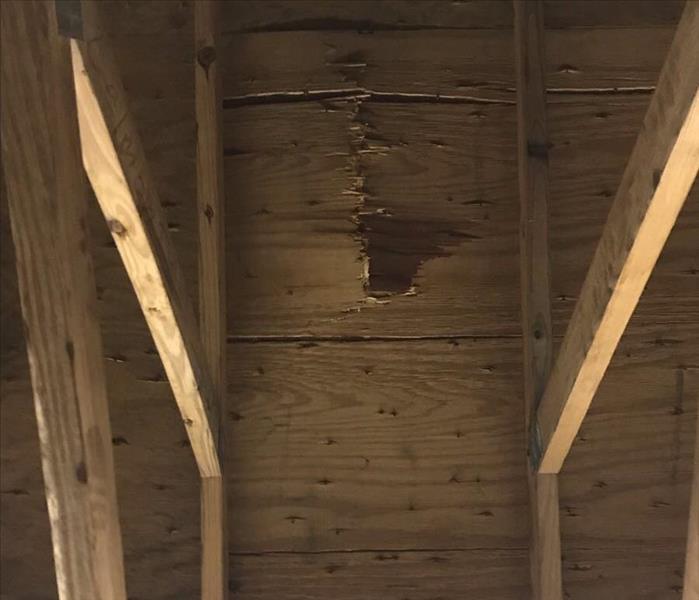 We are roof damage repair specialist!
We are roof damage repair specialist!
Storm damage is common in Ohio, and we want our Wilmington homeowners to have a protection plan in place to avoid severe damages.
SERVPRO of East Dayton/ Beavercreek is located in midwest America, which means we have a lot of different weather that we experience throughout the year. The residents of Wilmington experience strong winds from tornadoes, heavy rainfall, and snowstorms throughout the year. To help protect your most valuable asset, we have created 4 ways to protect your home from a storm. When your home suffers from storm damage, SERVPRO will make it "Like it never even happened."
1. Clear away patio items
When the weather channel advises that a storm is going to pass, the Wilmington residents must make sure that all of their lawn furniture, gardening tools, and sporting equipment are stored away in a secure space. High winds during a heavy storm will potentially pick up your yard items and send them flying through a window or damage your home's siding. Securing loose outdoor items during a storm event can protect your house from unnecessary damage.
2. Trim dead tree branches
The time is now to examine the trees that surround your property. Each year SERVPRO of East Dayton/ Beavercreek receives hundreds of calls that are from branches falling and damaging a Wilmington home.
Heavy storms will often snap large tree branches that can damage your home's siding, roofing, decks, and windows. Storms can even topple power lines and cause power outages to Wilmington neighborhoods. If there is a tree on your property with a clear loose connection, consider hiring an arborist to remove the dead branches. Removing the dead branches and trees in your yard may be expensive, but it will save you in the long run from damage to your home.
3. Invest in a generator
Tree branches can easily fall and snap the power lines. We have also seen first hand the power outages caused by lightning strikes. When lightning blows up a power transformer, you can guarantee major power outages will occur. To protect your home from potential power outages, we recommend investing in a quality power generator. With all of the storms that hit Ohio, investing in a generator is a great way to protect your home during storms and constantly back up. Our Owner Gary Shooter has invested in numerous generators to help keep us up and running when a storm hits Wilmington. We can power the equipment that we place in your home with our generators.
4. Water-proof your home
Rainstorms can lead to flooding, which can potentially major damage to your Wilmington home. Water damage devalues a house and causes significant problems with the foundation. The best way to ensure that your home is safe from potential water damage is to check for foundation leaks, clean out gutters, and replace broken windows. Also, be mindful of any pooling in the yard. Pooling is a clear indicator that drainage issues are making your home more susceptible to water damage.
SERVPRO of East Dayton/Beavercreek can come out and make sure your home is ready to fight against storm damage. If you would like one of our professionals to evaluate your home, please give us a call at (937) 228-3433
These four tips should help you be prepared in case of emergency, but if damage has already occurred, rely on the professionals at SERVPRO to clean up the damage. We are available 24/7 365 days a year.
More about Wilmington.
Beavercreek Tornado Damage Repair Specialist
6/8/2020 (Permalink)
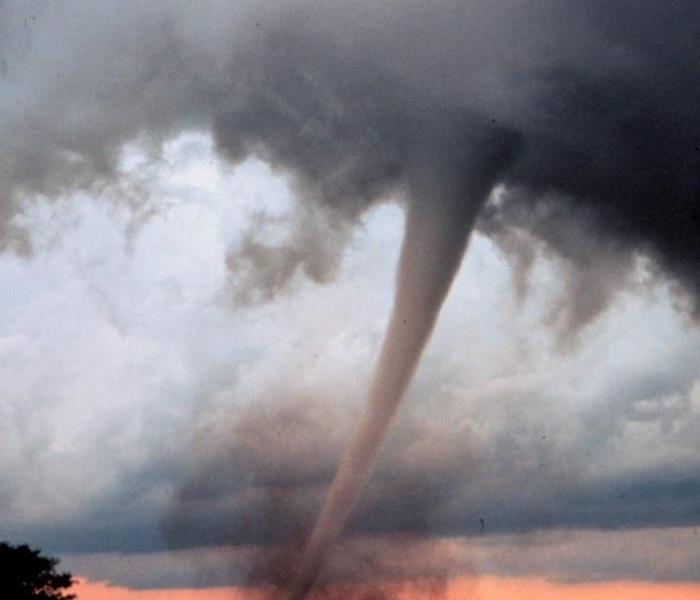 Dayton Ohio tornado causing damage to everything in its path.
Dayton Ohio tornado causing damage to everything in its path.
SERVPRO of East Dayton/Beavercreek is here to help during tornado damage aftermath
In 2019, approximately 49 tornadoes occurred in the state of Ohio. Compared to earlier years, 2016 was relatively quiet but still resulted in 24 tornadoes and over a million dollars in damage, according to OCSWA. Even if you don't live in a high-risk Ohio city like Beavercreek or Xenia, intense and violent tornadoes do occur. Depending on the type of tornado twister, you could have serious repercussions spinning your way.
Look out for Warnings
Tornadoes typically form when there are different speeds of wind at different altitudes. Tornadoes create a horizontal rotating column of air, also known as a supercell. When a supercell picks up enough condensation, it will form a funnel. When the National Severe Storms Laboratory alerts that a tornado watch is in effect, then you can guarantee that a tornado funnel has touched down within 250 miles. When a Beavercreek resident is issued a warning, serious precautions need to occur because there is a severe threat to your home and anyone in it.
What is Tornado EF?
Ohio residents have heard the term EF every time a tornado warning occurs. For those who are not aware, EF stands for Enhanced Fujita Scale, which was officially applied by the National Weather Service in 2007. The EF scale is a more accurate assessment of a tornado's characteristics than what the original Fujita Scale (F-Scale) stated. The current EF scale model designates wind speed ranges based on 28 damage indicators, including different structures and building types.
Each damage indicator has eight levels of damage:
EF-0
An EF-0 category tornado will most likely only produce relatively light damages to Beavercreek residents. EF-0 winds are still strong and will most likely produce small cracks to your home's structure. In your yard, there will be broken branches and fallen twigs. In some cases, you will see bent road signs.
EF-1
When an EF 1 category tornado touches down, you can expect winds anywhere from 86-165 mph. Heavy winds can rip apart your roof, or at the very least, multiple shingles. During an EF-1 category tornado, mobile homes are in danger because they can be overturned entirely with winds over 80 mph.
EF-2 to EF-3
Facing an EF-2 or EF-3 tornado in Ohio, you can bet that considerable damage will take place. Typically in EF2/3, large trees will fall, and some may become uprooted entirely. Man cars will be lifted off the ground, and objects in your yard will be flying around like torpedos fired from a submarine.
EF-4
When an Ohio meteorologist announces that an EF-4 tornado has touched down, you better be prepared. An EF-4 tornado can overturn a train. A train is not a home, but you best believe that it is a high possibility that your home will undergo severe damages. In most cases, once a broken window busts more wind to rush in and create pressure on the interior walls. When there is substantial wind pressure in your home, you can assume that your home roof will blow away.
EF-5
An EF-5 tornado is the worst or the worst for Beavercreek residents. This is where winds over 200 mph bring incredible damage and devastation. Large objects will be flying through the air as if they are as light as a balloon. Even the strongest constructed homes could be left to nothing. In some cases, these types of tornadoes cause foundations to be cleared.
Seeking Tornado Damage Help
SERVPRO of East Dayton/Beavercreek has seen it all when it comes to tornado damage. We can estimate all of your roof repairs and help mitigate any damages that may occur. You must have our number saved in your phone to fix any restoration and reconstruction that your home may require. All of our IICRC certified technicians are prepared to use the highest restoration techniques when restoring Beavercreek homes after a tornado.
Give SERVPRO of East Dayton/ Beavercreek a call at (937) 228-3433 for any tornado damage or water removal in Dayton. Let the professionals, like the experts here at SERVPRO, help you.
For more information about Dayton.
Our SERVPRO Technicians Can Quickly Assess your Property After a Flood
3/30/2020 (Permalink)
Floods cause a great deal of damage and can come from many sources. The worst floods come from external sources, although it is possible that clean water from burst water lines can become contaminated inside our home, making them almost as bad as floods originating outside your home. Contaminants make things especially hazardous to your health, but here are other dangers that can lurk inside your home after a flood has receded.
In Dayton, flood damage can include silt and soils left behind in your appliances. These can retain moisture, creating not only breeding grounds for microorganisms but also moist environments that cause rust and other corrosive actions. As you know, rust can ruin your electric appliances over time, even if they seemed fine at first. Hot water heaters are especially dangerous because silt can shift, blocking pilot lights and creating gas leaks in the process. The same is true of gas dryers and ovens.
It is vital to have your home appliances examined by a qualified professional to check and to make repairs on them. While we at SERVPRO are excellent at cleaning such items, we want to make sure that they are in perfect working order and recommend that these always also be examined by a certified technician after we have cleaned them. Most water damage technicians will not clean appliances to the degree required after a flood, but we can.
Other cleaning aspects can help you preserve your wood floors. After a flood, you are not merely battling moisture. You are also working to remove sediments that can act like sandpaper in your home. Some of this sediment is so fine, it can become airborne, and when breathed in, it can irritate your nasal passages and throat. Air scrubbers can help remove these particles, just like they do mold spores. As we dry your home with our heaters and air movers, we can also place our air scrubbers in the most effective locations to catch much of the silt, and other particles, floating in the air, making your home air much cleaner in the long run for you and your family.
When you find yourself coping with flood damage, give us, SERVPRO of East Dayton/Beavercreek a call at (937) 228-3433. Day or night, we are here to help you fight restoration emergencies.
To Mitigate Storm Effects, We Suggest Immediate Water Extraction!
3/2/2020 (Permalink)
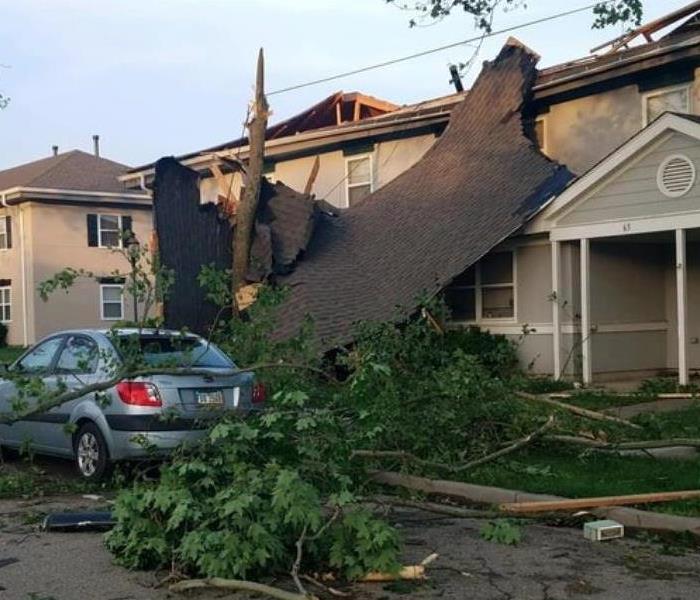 Storm Damage in Dayton Ohio
Storm Damage in Dayton Ohio
Following flooding as a result of storm damage, many objects and parts of your home will be soaked to differing degrees. Some areas may be very lightly touched by moisture, and will, as a result, dry out quickly. Others, however, may be inundated and soaked through by floodwaters, including porous materials such as carpeting and fabrics. Aside from the sheer volume of water, some other factors will also significantly affect the rate at which your home dries out.
Water Extraction
The most important part of the drying process for storm damage in Beavercreek is bulk water removal. Our drying technology, while thorough and adaptable, is by nature capable of the removal of far less water than a traditional pumping system. For example, our truck-mounted water extractors can move up to 36,000 gallons per day, but our drying systems are often limited to around 30 gallons daily under optimal conditions. We prioritize getting service crews on-scene within hours of an initial call, so to be sure to keep drying times as low as possible.
Air Movement
We use high-powered air movers to create strong currents of air in a drying room. These capture water droplets and vapor from all surfaces and are then coupled with thermal or chemical dehumidifiers to take the water back out of the air and into a holding tank or piped directly to the exterior of the structure.
Temperature
Temperature profoundly affects the rate at which water evaporates, and thus the drying rate of your home. The ideal drying temperature is typically anywhere from 70-90 degrees Fahrenheit, as at any lower, our air movers will not be able to pick up much moisture. Any higher and the air becomes too humid for optimal results.
Relative Humidity--RH
Finally, the most important factor is the relative humidity. Many of our tools and even the factors described above are related to and designed to accommodate moisture. One device we use to measure this important component of drying is a thermal hygrometer. Humidity must be kept at a relatively ordinary level, so as to encourage fast evaporation and removal but also to avoid further damage to the room.
SERVPRO of East Dayton/ Beavercreek carries advanced equipment and specialized techniques to help dry out your home as fast as possible following a storm. If your home has experienced storm damage, call us at (937)-228-3433
Determining Flood Damage In Dayton
2/17/2020 (Permalink)
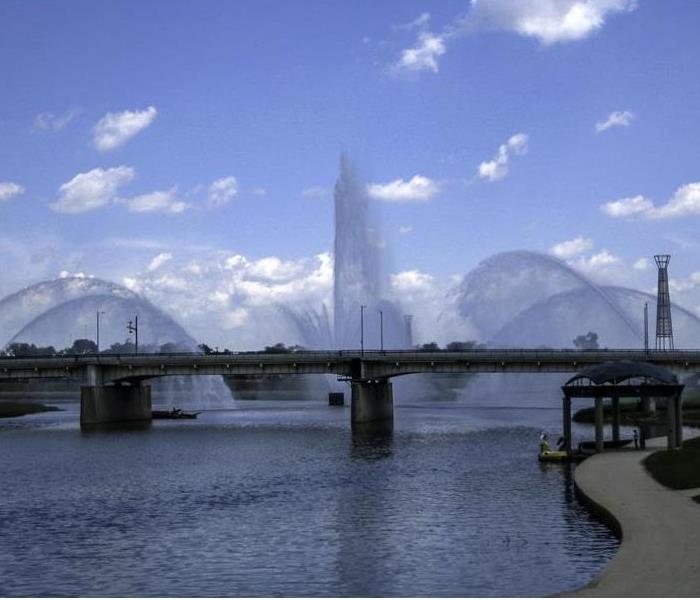 Patterson Boulevard Bridge Dayton, Ohio
Patterson Boulevard Bridge Dayton, Ohio
Dayton Flood Damage in your home
Removing stormwater from a Dayton home is much like removing water from a broken water heater. The equipment needed is the same, but there are additional precautions to take depending on if this outside water is contaminated. The same concerns are there when it comes to restoring the property.
SERVPRO of East Dayton understands that after a flood, Dayton homeowners want to get back into their house, and to their life before they wake up to find ankle-deep water in their living room and kitchen. To make certain we can provide a safe, clean environment; our restoration team first checks to see if the water is Clean, Gray, or Black.
Clean floodwater contains no threatening microbes and does not pose a risk to the health of the homeowners or other residents. Team members bring in the same pumps and extraction wands used to clean up after a broken kitchen sink sends water across the linoleum. Clean water can become contaminated if it stands too long, so we begin to remove it as soon as we get the first pump-off our truck. We also start to lower the humidity level since dry air also inhibits microbial growth.
Gray water contains low levels of microbes and other contaminants. The majority of them are usually urine or wash water forced out of overwhelmed sewers after a severe storm. This results in rapid microbial growth and the bacteria or fungi pose a threat to anyone who comes in contact with it. These same microbes can spread to walls and furniture as the water recedes and become a threat to property. To kill the microbes and prevent spreading them, SERVPRO technicians spray an anti-fungal agent across the surface of the water and nearby property before taking any other actions.
Blackwater is a severe threat to people and property. According to IICRC, the flood water has drawn in everything from the surrounding area as it rises. That includes animal waste, carcasses, and even sewage when the force of the water splits lines open. Since this contamination is obvious, our technicians pull on protective gear like rubber suits and even breathing gear. Once protected, they spray the water and nearby property before bringing in any pumps or other extraction gear.
For both Black and Gray water, we pump out the water into the nearest, functioning sewer opening. If there isn't one available, then we pump it into a tanker truck for removal to the nearest wastewater treatment plant.
What Time of Year Do Storms Mostly Occur?
10/29/2019 (Permalink)
 Summer fun doesn't have to end just because of a seasonal storm.
Summer fun doesn't have to end just because of a seasonal storm.
Every year there are an average of 100,000 thunderstorms, 10% of which are categorized as severe storms. Though this is a year-round statistic, most storms take place within the spring and summer months, between the hours of noon and midnight. The reason why this time of year is beneficial for the formation of thunderstorms is due to the warming of the Earth. Starting in the spring and especially in the summer, the sun is out for longer than it is during the fall or winter. This gives sunlight time to warm the surface of the Earth, therefore warming the air surrounding the areas where this is happening. While most of us enjoy this process because it makes the temperature perfect for going outside, it creates the ideal conditions for a thunderstorm to form. Though air near the surface of the Earth becomes hotter during these months, the air higher in the sky remains below freezing throughout the entire year. Therefore, when something triggers the warmer air upwards, colliding with the freezing air, the contact of these differing temperature particles creates electric charges. In the fall and winter the air near the surface is cooler, due to less sunlight and distance from the sun, so should the surface air collide with the distant air, there is no opposing force to cause electric charges. It makes sense why we relate thunderstorms to the summer, then.
What this means for homeowners is that summertime is when storm damage is most likely to occur. While we have differing concerns for each season, warm weather brings general storm damage opportunities. Heavy rainfall can create floods which pose a threat of water damage. Lightning strikes can cause fire damage if they hit near our homes. There’s a lot to think about in the otherwise enjoyable warm months of the year.
However storms affect the home, SERVPRO of East Dayton covers any destruction that may come from a storm. Summer is the time of year we allow ourselves to kick back, relax, and enjoy the sunlight. Don’t let storm damage stop you from experiencing summer relaxation. Call your local SERVPRO for any storm damage needs.
The Necessities for Storm Preparation
10/21/2019 (Permalink)
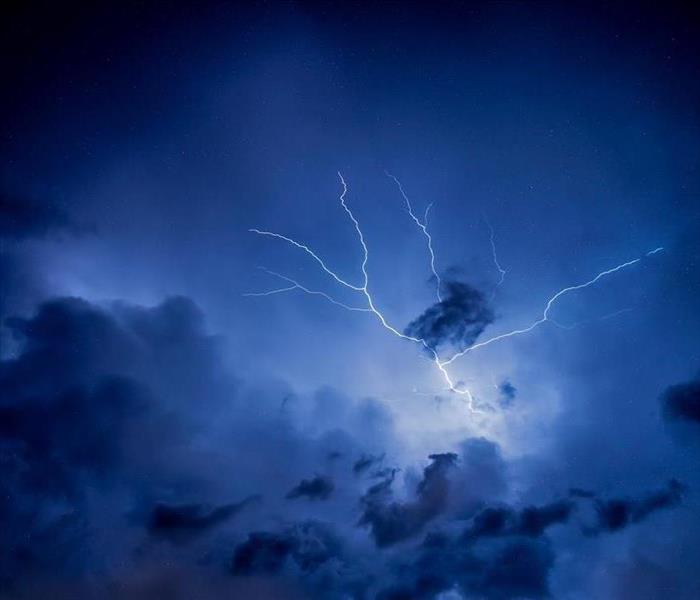 Lightning from a far distance is amazing, but less so when it gets closer to our homes.
Lightning from a far distance is amazing, but less so when it gets closer to our homes.
The United States is the World’s Tornado Capital, specifically the midwest region including states like Texas, Kansas, Oklahoma, and Ohio. We can’t save our home from the inevitable effects of severe storms. However, we can save our families by having a storm kit easily accessible in our home. Some 0bvious things to keep in a storm kit: a first aid kit, list of emergency phone numbers, bottled water, nonperishable food, battery powered flashlight, and extra batteries. But what about the less obvious things? Other necessities could be: extra cash (kept in a water-tight bag), extra clothing (also kept in a water-tight bag), a non-electric can opener, sturdy boots, and prescriptions or required medicine. What are the things our families cannot survive without on a daily basis? We may forget our medicines or dry clothing when we focus on dealing with disaster. The most important thing to consider when a storm is on its way is how to care for your family. Storm damage on the structure of the home can be repaired afterwards. Storm damage in Beavercreek happens mostly to neighborhoods. Focus on caring for your family when a storm heads your way. Luckily, our local news station provides us with storm tracker information so we can know where the storm is located. After it ends, if storm damage occurs stress can be limited with the help of SERVPRO, a company of professionals in storm damage restoration. They focus on returning the quality of our homes and businesses to before the storm even hit. Knowing how to protect our family and who to call when damage ensues is all we need when storms are on their way. SERVPRO can take the stress out of the uncontrollable weather.
The Difference Between a Storm Warning and a Storm Watch
10/21/2019 (Permalink)
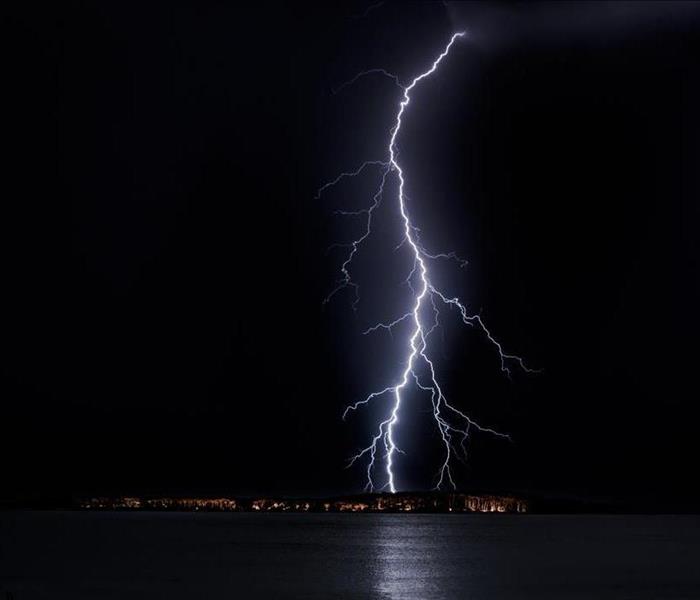 During a storm, lightning is looking for the strongest pull to the Earth. Wherever that pull is, damage always follows.
During a storm, lightning is looking for the strongest pull to the Earth. Wherever that pull is, damage always follows.
Population size can affect the severity of a storm by at least 2% in rainfall. This is due to a higher temperature in cities like Dayton, Ohio. Our phones have the convenient ability to alert us of an oncoming storm, whether the storm happens tonight, tomorrow, or within the next few days. However these alerts come with two different descriptions of the storm, a storm watch or a storm warning. Without being informed on the difference between the two, how can we know how prepared we need to be for storms headed our way? Here’s the difference. A storm warning is a less severe storm message.
A storm warning is for a storm that:
- will arrive soon
- lasts between twenty minutes and an hour
- covers only portions of a county
- indicates we should take cover when the message is received
A storm watch is for a storm that:
- will arrive within a few hours
- lasts for several hours
- can cover across multiple states
- indicates we should have a plan prepared for when it arrives
With this information, we can better prepare ourselves for when that message shows up on phones. The next time a storm message arrives, whether a watch or a warning, save your stress about the possibility of damage until the following day. And before looking for how to handle storm damage from last night, consider hiring storm damage specialists directly from businesses like your local SERVPRO, who have the power of a commercial company with the speed and customer service of a local company. SERVPRO can take all the hassle out of the inevitable. While we cannot avoid the path of a storm, they can restore our homes as though storms never happen.
Types of Storms and What to Look For
10/21/2019 (Permalink)
 We can usually tell what is headed our way, even from a far distance. A build up of clouds like this indicate a storm is coming.
We can usually tell what is headed our way, even from a far distance. A build up of clouds like this indicate a storm is coming.
Lightning strikes are 50,0oo°Fahrenheit, which is five times hotter than the surface of the Sun. That’s a terrifying fact knowing how often these strikes hit the surface of the Earth. While cool storm videos are cool to watch, it’s less fun when the storm we’re watching is headed our way. There are many types of storms that can affect our lives. The most common types of storms include: thunderstorms, hail storms, blizzards, tornadoes, floods, and hurricanes. Each storm can make itself obvious from the formation of the sky when it occurs. For example, a thunderstorm often presents itself as an anvil shaped cloud at first, low and flat at the bottom while standing tall. An easy way to tell it’s a blizzard and not just regular snow is the visibility. Blizzards lessen the visibility for at last three hours, usually longer. Hail storms can present a variety of danger as the hail itself can be as small as peas and as large as watermelons. While larger hail can have more powerful damage, crushing cars, roofs, windows, etc, small hail can also break windows and create holes in roofs. Fortunately, storms may cause inevitable damage to our homes but not irreversible damage. Storm damage assessments are not hard to receive, especially from specialists like your local SERVPRO of East Dayton. It can be fun to know more about types of storms when we’re aware of how close a storm damage professional is, and how easy it is for a company like SERVPRO to return our home as if the damage never occurred.
Measuring the Size of a Potential Storm at Home
10/21/2019 (Permalink)
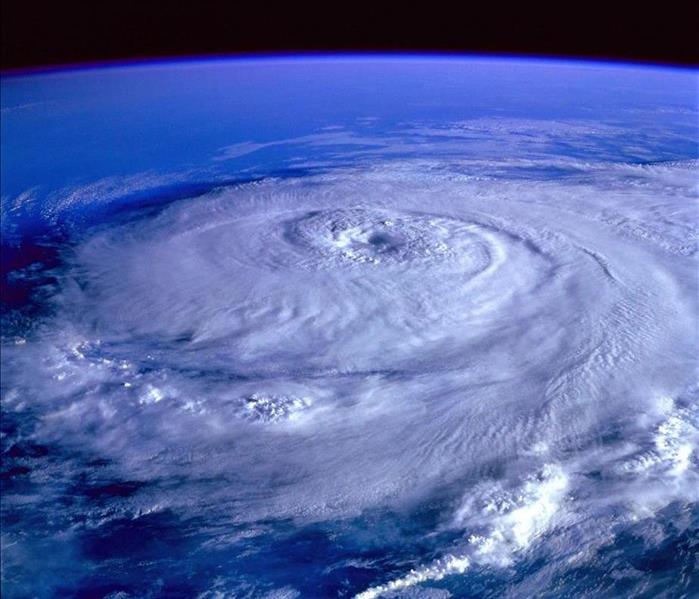 Nature is beautiful but can rob us of time and money when storms happen to us.
Nature is beautiful but can rob us of time and money when storms happen to us.
In 2018 climate disasters cost Americans a total of $91.0 billion in damage. Some storms drift by without a single scratch on our homes. Some storms cause damage that causes us both stress and money. While we receive storm warnings and watches from our phones, TVs, and computers, news channels cannot assess personal damage to each individual family home. Storm and rain damage can lead to other issues, not only destroying the structure of the home but creating leaks from burst pipes, water buildup, and other internal issues. The best thing to do for prevention of storm damage would be to consistently monitor the integrity of our roof and pipes. Of course that isn’t always manageable with a busy schedule. No one can blame homeowners for not knowing every detail of their home, especially when damage will occur regardless. In order to tell if storm damage is potential, consider the following. Is it a storm warning or a storm watch? Storm watches are more severe storms, therefore more likely to do damage. What other factors does a specific storm bring? Large enough sized hail can do roof damage, shatter windows, and dent cars. If storm damage does occur, leave the stress to storm damage specialists. A storm damaged roof is a dangerous site to repair, and companies like SERVPRO are equipped with the necessary equipment to repair while staying safe and avoiding further damage. Once the structure of the roof has been secured again, tiles can be replaced and secured easily. The process not only repairs previous damage, but can prevent damage in the future by reinforcing the strength of a storm damaged roof.
How Secure is Your Roof During a Storm?
10/21/2019 (Permalink)
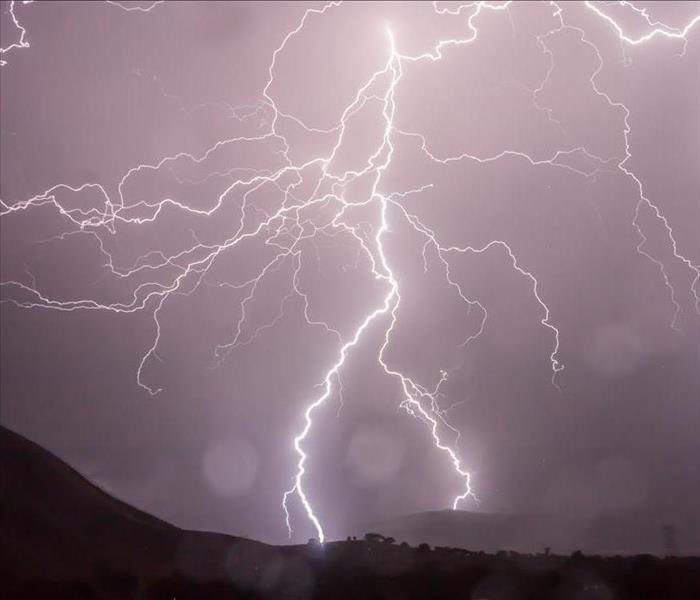 Thunderstorms may be common enough to not worry us, but the damage is drastic.
Thunderstorms may be common enough to not worry us, but the damage is drastic.
Lightning can and will strike the same place twice, regardless of the myth that “Lightning never strikes the same spot twice.” This is bad news for anyone with Astraphobia, the fear of thunder and lightning. Astraphobia is the third most common phobia in the United States, which is probably why someone made up the myth that lightning strikes certain areas only once. If a location has the electric current to pull a strike of lightning down to Earth, that won’t go away after it a strike has already happened. When a thin tree fell on the roof of a local Beavercreek family and broke through the structure, they didn’t know where to begin. It can seem intimidating at first, especially from something unsuspecting like a smaller sized tree. Damage from storms can be unpredictable and uncontrollable, leaving homeowners like the ones we worked with confused on where to even begin. Luckily, they found SERVPRO of East Dayton through a neighbor that had worked with them to repair water damage months prior. The benefit of a company like SERVPRO of Beavercreek is the power of a commercial business with the care of a local business. The people of this SERVPRO work are ready to repair whatever damage ensues as soon as the calls arrive. The goal of any damage restoration company is to make larger than life issues not as big as they seem. SERVPRO does this by arriving to the site promptly and repairing the damage as efficiently as possible.



 24/7 Emergency Service
24/7 Emergency Service























